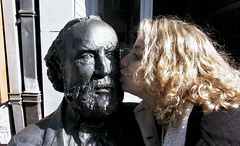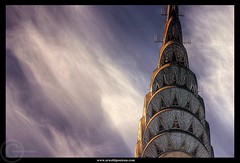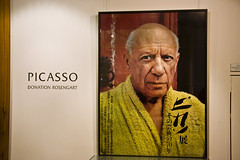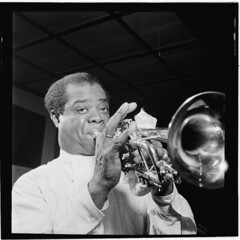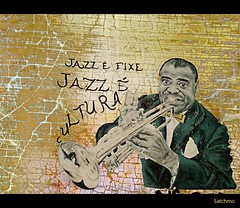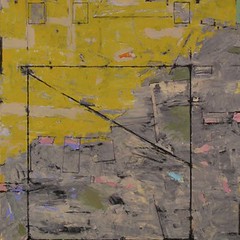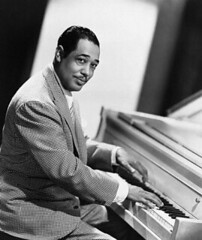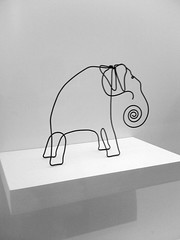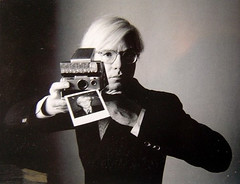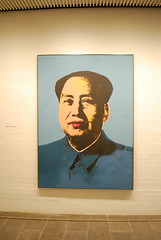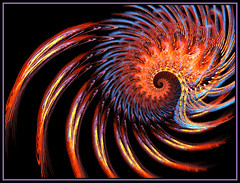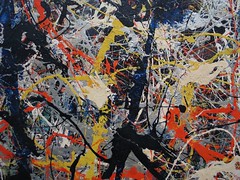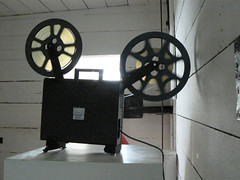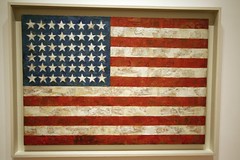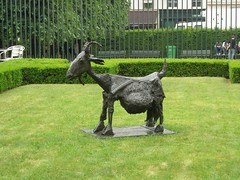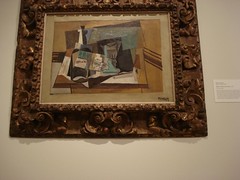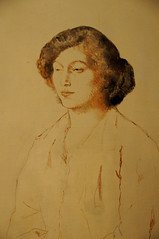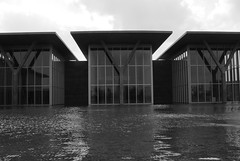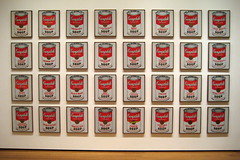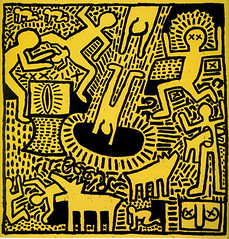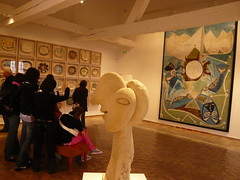Style show: a project for 2nd semester:
- a multi-media dress-up show.
- each Fine Arts student would be a model in this show.
- find a style that includes a blazer or vest or sweater and that reflects casual elegance.
- your appearance will be accompanied by a projected presentation.
- include images of variations on the look you have chosen.
- include remarks from your
* mother
* father
* style-conscious classmate
- include brief musical background.
- include a reference that connects your style to classical apparel.
- show will be presented to classmates in arts-related classes.
A reference story from the New York Times.
Style show will be preceded by a unit on the history of apparel. Eras upon which we will peer:
Greek
Roman
Chinese
Medieval
Renaissance
Reformation
Industrial Revolution
turn-of-the-century
Roaring Twenties
WWII
Fifties
Late 60's
80's
Friday, December 18, 2009
Mozart and Bach: describing the differences between the 2 giants of classical music
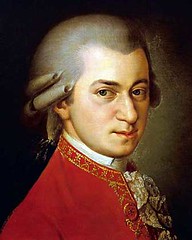
Johannes Chrysostomus Wolfgangus Theophilus Mozart (January 27th, 1756 - December 5th, 1791)
Originally uploaded by violinsoldier
You will hear the music of these two composers in every phase of your life. My goal is to enable you to have a clear and concise way of distinguishing between them.
- Include the titles of their well-known tunes, aka their works or pieces.
- Use no less than 10 images. Edit the biographical material so that each image has about 4 brief items.
- Document. List all the sites that provide your material.
- Think in terms of presenting this project to a Magnet history class.
Thursday, December 17, 2009
Saxophones would be hellaciously long if they weren't curved
The saxophone is a conical-bored transposing musical instrument considered a member of the woodwind family, says Wikipedia.
Saxophones are usually made of brass and are played with a single-reed mouthpiece similar to that of the clarinet. The saxophone was invented by Adolphe Sax in 1841.
He wanted to create an instrument that would both be the loudest of the woodwinds and the most versatile of the brass, and would fill the then vacant middle ground between the two sections.
The simplest design of saxophone is a straight conical tube, and the sopranino and soprano saxophones are usually of this straight design. However, as the lower-pitched instruments would be unacceptably long if straight, for ergonomic reasons the larger instruments usually incorporate a U-bend at or slightly above the third-lowest tone hole. As this would cause the bell of the instrument to point almost directly upwards, the end of the instrument is either beveled or tilted slightly forwards. This U-shape has become an iconic feature of the saxophone family, to the extent that soprano and even sopranino saxes are sometimes made in the curved style even though this is not strictly necessary.
Saxophones are usually made of brass and are played with a single-reed mouthpiece similar to that of the clarinet. The saxophone was invented by Adolphe Sax in 1841.
He wanted to create an instrument that would both be the loudest of the woodwinds and the most versatile of the brass, and would fill the then vacant middle ground between the two sections.
The simplest design of saxophone is a straight conical tube, and the sopranino and soprano saxophones are usually of this straight design. However, as the lower-pitched instruments would be unacceptably long if straight, for ergonomic reasons the larger instruments usually incorporate a U-bend at or slightly above the third-lowest tone hole. As this would cause the bell of the instrument to point almost directly upwards, the end of the instrument is either beveled or tilted slightly forwards. This U-shape has become an iconic feature of the saxophone family, to the extent that soprano and even sopranino saxes are sometimes made in the curved style even though this is not strictly necessary.
Jazz would not be quite that same without the work of Adolphe Sax in the 1800's
Antoine-Joseph "Adolphe" Sax (November 6, 1814 – February 4, 1894[1]) was a Belgian musical instrument designer and musician who played the flute and clarinet, and is best known for inventing the saxophone, says Wikipedia.
He patented the saxophone in 1846.
Composer Hector Berlioz wrote approvingly of the new instrument in 1842.
By 1846 Sax had designed, on paper, a full range of saxophones (from sopranino to subcontrabass). Although they never became standard orchestral instruments, the saxophones made his reputation, and secured him a job teaching at the Paris Conservatoire from 1867.
He patented the saxophone in 1846.
Composer Hector Berlioz wrote approvingly of the new instrument in 1842.
By 1846 Sax had designed, on paper, a full range of saxophones (from sopranino to subcontrabass). Although they never became standard orchestral instruments, the saxophones made his reputation, and secured him a job teaching at the Paris Conservatoire from 1867.
John Coltrane, one of the most powerful and influential jazz saxophonists
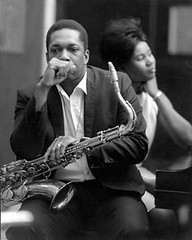
John Coltrane and Alice Coltrane during the 1960s. The couple made monumental contributions in the field of music and social consciousness.
Originally uploaded by Pan-African News Wire File Photos
Working in the bebop and hard bop idioms early in his career, Coltrane helped pioneer the use of modes in jazz and later was at the forefront of free jazz.
He was prolific, making about fifty recordings as a leader during his recording career, and appeared as a sideman on many other albums, notably with trumpeter Miles Davis and pianist Thelonious Monk. As his career progressed, Coltrane's music took on an increasingly spiritual dimension. His second wife was pianist Alice Coltrane, and their son Ravi Coltrane is also a saxophonist.
He influenced innumerable musicians, and remains one of the most significant tenor saxophonists in jazz history.
As a teen he left his home in High Point, NC, and moved to Philadelphia. He studied music; he enlisted in the Navy.
In 1945 he saw Charlie Parker perform for the first time. In a DownBeat article in 1960 he recalled: "the first time I heard Bird play, it hit me right between the eyes.
Miles Davis found him and invited him to join his quintet. In 1956 they did the albums issued as Cookin', Relaxin', Workin', and Steamin', some of the most treasured titles in Davis's early discography. The group disbanded in mid April due partly to Coltrane's problematic heroin addiction.[1]
During the later part of 1957 Coltrane worked with Thelonious Monk at New York’s Five Spot, a legendary jazz club, and played in Monk's quartet. The resulting album, Thelonious Monk Quartet with John Coltrane at Carnegie Hall, has been widely acclaimed.
Coltrane rejoined Davis in January 1958. In October 1958, jazz critic Ira Gitler coined the term "sheets of sound" to describe the style Coltrane developed during his stint with Monk and was perfecting in Miles' group, now a sextet. His playing was compressed, with rapid runs cascading in hundreds of notes per minute. During this time he performed on Kind of Blue, and the live recordings Miles & Monk at Newport and Jazz at the Plaza.[1]
Coltrane recorded his first album comprising his own compositions exclusively, Giant Steps. The title track is generally considered to have the most complex and difficult chord progression of any widely-played jazz composition.
With Atlantic Records, for whom he had recorded Giant Steps, his first record with a new group was also his debut playing the soprano saxophone; the album was the hugely successful My Favorite Things.
In the early 1960's he recorded for Impulse Records and expanded his experimental style. Critics were fiercely divided in their estimation of Coltrane. Audiences, too, were perplexed; in France he was famously booed during his final tour with Davis. In 1961, Down Beat magazine indicted Coltrane, along with Eric Dolphy, as players of "Anti-Jazz" in an article that bewildered and upset the musicians.
He responded by making albums which were more conservative and accessible. He recorded an album of ballads and participated in collaborations with Duke Ellington on the album Duke Ellington and John Coltrane and with deep-voiced ballad singer Johnny Hartman on an eponymous co-credited album.
His quartet produced their most famous record, A Love Supreme, in December 1964. A culmination of much of Coltrane's work up to this point, this four-part suite is an ode to his faith in and love for God. These spiritual concerns would characterize much of Coltrane's composing and playing from this point onwards, as can be seen from album titles such as Ascension, Om and Meditations.
Recordings in the first half of 1965 show Coltrane's playing becoming increasingly abstract, with greater incorporation of devices like multiphonics, utilization of overtones, and playing in the altissimo register, as well as a return to Coltrane's sheets of sound. In the studio, he abandoned his soprano to concentrate on the tenor saxophone. In addition, the quartet responded to the leader by playing with increasing freedom.
In 1965 Coltrane may have begun using LSD[8][9] - informing the sublime, "cosmic" transcendence of his late period, and also its incomprehensibility to many listeners. Drummer Philly Joe Jones's and pianist McCoy Tyner's departed. Coltrane and saxophonist Pharaoh Sanders were described by Nat Hentoff as "speaking in tongues". When touring, the group was known for playing very lengthy versions of their repertoire, many stretching beyond 30 minutes and sometimes even being an hour long. Concert solos for band members regularly extended beyond fifteen minutes in duration.
Coltrane died from liver cancer at Huntington Hospital on Long Island in 1967, at the age of 40. Biographer Lewis Porter has suggested, somewhat controversially, that the cause of Coltrane's illness was hepatitis, although he also attributed the disease to Coltrane's heroin use.[10]
Tuesday, December 15, 2009
History of jazz presentation using Miles Davis and one additional figure
With a partner, please develop a 10-image history of jazz presentation in Google Docs.
* Using 3 bulleted items per image, compare the fine arts impact of Miles Davis to another 20th century musical artist. Each student will use 4 images in developing the biography and one image on comparison.
* Document each slide in fine type at the lower edge.
* Due at the end of the hour. 3 pts.
* Though the project must be filed in your GoogleDocs, please do Not send notification to trudeau11.
20th century cats -
- Duke Ellington
- John Coltrane
- Igor Stravinsky
- Aaron Copeland
- Billie Holiday
- Ella Fitzgerald
- Nat King Cole
- Jellyroll Morton
- Joe King Oliver
- Wynton Marsalis
- Leonard Bernstein
- Thelonius Monk
- Charlie Parker
For concise biographies, please see the Ken Burns Jazz site.
* Using 3 bulleted items per image, compare the fine arts impact of Miles Davis to another 20th century musical artist. Each student will use 4 images in developing the biography and one image on comparison.
* Document each slide in fine type at the lower edge.
* Due at the end of the hour. 3 pts.
* Though the project must be filed in your GoogleDocs, please do Not send notification to trudeau11.
20th century cats -
- Duke Ellington
- John Coltrane
- Igor Stravinsky
- Aaron Copeland
- Billie Holiday
- Ella Fitzgerald
- Nat King Cole
- Jellyroll Morton
- Joe King Oliver
- Wynton Marsalis
- Leonard Bernstein
- Thelonius Monk
- Charlie Parker
For concise biographies, please see the Ken Burns Jazz site.
Saturday, December 12, 2009
A tour of Manhattan multiple choice test
Choose the best location description - in Manhattan, unless otherwise noted. Please send & save your answers via GoogleDocs.
1. Harlem: a) Above Central Park b) South of Theater District c) Midtown d) Upper West Side.
2. Columbia U.: a) Upper West Side b) Upper East Side c) Midtown d) Harlem.
3. Fifth Ave.: a) Upper West Side b) Upper East Side c) Midtown d) Lower East Side.
4. The Dakota (apt bldg): a) Upper West Side b) Upper East Side c) Midtown d) Harlem.
5. Metropolitan Museum of Art: a) Central Park b) Greenwich Village c) Financial District.
6. Guggenheim Museum: a) Central Park b) Greenwich Village c) Financial District d) SoHo.
7. Plaza Hotel: a) Central Park b) Theater District c) Tribeca d) Upper West Side.
8. Lincoln Center: a) Upper West Side b) Upper East Side c) Midtown d) Harlem.
9. Metropolitan Opera House: a) a) Central Park b) Greenwich Village c) Financial District d) Upper West Side.
10. Rockefeller Center: a) Upper West Side b) Upper East Side c) Midtown d) SoHo.
11. UN Headquarters: a) Hudson R b) East R c) Harlem R d) Long Island Sound.
12. Broadway: a) North-South b) East-West c) Bronx-Manhattan-Brooklyn.
13. Carnegie Hall: a) Upper West Side b) Upper East Side c) Midtown d) SoHo.
14. MoMA / Museum of Modern Art: a) Upper West Side b) Upper East Side c) Midtown d) Lower East Side.
15. Empire State Bldg. is at 34th St and a) Fifth Ave b) Broadway c) 42nd St.
16. Washington Square Park: a) Central Park b) Greenwich Village c) Financial District d) Upper West Side.
17. NYU: a) Central Park b) Greenwich Village c) Financial District d) Upper West Side.
18. Greenwich Village: a) Upper West Side b) Upper East Side c) Above Midtown d) Above SoHo.
19. Chrysler Bldg: a) Upper West Side b) Upper East Side c) Midtown d) Lower East Side.
20. Lower East Side: a) Brooklyn Bridge b) George Washington Bridge c) Lincoln Tunnel d) Staten Is Ferry.
21. Little Italy & Chinatown: a) Upper West Side b) Upper East Side c) Midtown d) Lower East Side.
22. Wall St / Financial District: a) New Amsterdam b) Greenwich Village c) Harlem
d) Upper East Side.
23. NYSE is closer to a) 1st St b) 34th St c) 42nd St d) 155th St
24. Former World Trade Center site closer to: a) Wall St. b) 42nd St c) Brooklyn Bridge d) Fifth Ave.
25. Battery Park: a) Upper West Side b) Upper East Side c) Midtown d) Financial District.
26. New Amsterdam: a) Upper West Side b) Upper East Side c) Midtown d) Financial District.
27. 42nd St: a) Garment District b) Financial District c) Theater District d) Spanish Harlem.
28. Lenox Ave / Malcolm X Blvd: a) Upper West Side b) Upper East Side c) Midtown d) Harlem.
1. Harlem: a) Above Central Park b) South of Theater District c) Midtown d) Upper West Side.
2. Columbia U.: a) Upper West Side b) Upper East Side c) Midtown d) Harlem.
3. Fifth Ave.: a) Upper West Side b) Upper East Side c) Midtown d) Lower East Side.
4. The Dakota (apt bldg): a) Upper West Side b) Upper East Side c) Midtown d) Harlem.
5. Metropolitan Museum of Art: a) Central Park b) Greenwich Village c) Financial District.
6. Guggenheim Museum: a) Central Park b) Greenwich Village c) Financial District d) SoHo.
7. Plaza Hotel: a) Central Park b) Theater District c) Tribeca d) Upper West Side.
8. Lincoln Center: a) Upper West Side b) Upper East Side c) Midtown d) Harlem.
9. Metropolitan Opera House: a) a) Central Park b) Greenwich Village c) Financial District d) Upper West Side.
10. Rockefeller Center: a) Upper West Side b) Upper East Side c) Midtown d) SoHo.
11. UN Headquarters: a) Hudson R b) East R c) Harlem R d) Long Island Sound.
12. Broadway: a) North-South b) East-West c) Bronx-Manhattan-Brooklyn.
13. Carnegie Hall: a) Upper West Side b) Upper East Side c) Midtown d) SoHo.
14. MoMA / Museum of Modern Art: a) Upper West Side b) Upper East Side c) Midtown d) Lower East Side.
15. Empire State Bldg. is at 34th St and a) Fifth Ave b) Broadway c) 42nd St.
16. Washington Square Park: a) Central Park b) Greenwich Village c) Financial District d) Upper West Side.
17. NYU: a) Central Park b) Greenwich Village c) Financial District d) Upper West Side.
18. Greenwich Village: a) Upper West Side b) Upper East Side c) Above Midtown d) Above SoHo.
19. Chrysler Bldg: a) Upper West Side b) Upper East Side c) Midtown d) Lower East Side.
20. Lower East Side: a) Brooklyn Bridge b) George Washington Bridge c) Lincoln Tunnel d) Staten Is Ferry.
21. Little Italy & Chinatown: a) Upper West Side b) Upper East Side c) Midtown d) Lower East Side.
22. Wall St / Financial District: a) New Amsterdam b) Greenwich Village c) Harlem
d) Upper East Side.
23. NYSE is closer to a) 1st St b) 34th St c) 42nd St d) 155th St
24. Former World Trade Center site closer to: a) Wall St. b) 42nd St c) Brooklyn Bridge d) Fifth Ave.
25. Battery Park: a) Upper West Side b) Upper East Side c) Midtown d) Financial District.
26. New Amsterdam: a) Upper West Side b) Upper East Side c) Midtown d) Financial District.
27. 42nd St: a) Garment District b) Financial District c) Theater District d) Spanish Harlem.
28. Lenox Ave / Malcolm X Blvd: a) Upper West Side b) Upper East Side c) Midtown d) Harlem.
Thursday, December 10, 2009
Picasso: interactive biography
How to visit New York City on a tight budget
For those of us who live here, the expense of New York City is something we’ve long since adjusted to, says NY Times writer Matt Gross.
Designer tank tops for $140, truffled hamburgers for $150, studio apartments renting for upward of $3,000 — even in the midst of recession, these things seem somehow normal, the price of admission to the greatest city in the world.
For visitors, however, these can be seriously intimidating numbers. Even if you’re not aiming for high-end Manhattan indulgence, the basic costs of lodging, transportation, food, shopping and entertainment are the most expensive in the nation.
But there’s an easy way to bring the price of a New York vacation down to earth. It’s called research.
About six months ago, I put together a frugal traveler’s guide to trip planning, which involved lots of Googling and various Web sites like Craigslist and Oanda.com. Now I’ve created one specifically for New York City, offering what I hope is everything you’ll need to figure out how to have a good time without a Wall Street bonus.
Designer tank tops for $140, truffled hamburgers for $150, studio apartments renting for upward of $3,000 — even in the midst of recession, these things seem somehow normal, the price of admission to the greatest city in the world.
For visitors, however, these can be seriously intimidating numbers. Even if you’re not aiming for high-end Manhattan indulgence, the basic costs of lodging, transportation, food, shopping and entertainment are the most expensive in the nation.
But there’s an easy way to bring the price of a New York vacation down to earth. It’s called research.
About six months ago, I put together a frugal traveler’s guide to trip planning, which involved lots of Googling and various Web sites like Craigslist and Oanda.com. Now I’ve created one specifically for New York City, offering what I hope is everything you’ll need to figure out how to have a good time without a Wall Street bonus.
Wednesday, December 9, 2009
Louis Armstrong and the Giants of Jazz
Jazz & Vocab quiz and answers
Sony window
Originally uploaded by trudeau
1. Ellington Great pianist as well as band leader and composer?
2. Ellington Famous as a New Yorker but was a native of Washington, DC?
3. Armstrong Loved smoking reefer?
4. Armstrong Cut some great records in Chicago?
5. Ellington Famous for the tune "Take the A Train"?
6. Armstrong Famous for his performances of the tune "Basin St Blues"?
7. Reinhardt Played his instrument with 2 fingers?
8. Armstrong Married 4 times?
9. Reinhardt Born and raised in Belgium?
10. Armstrong Wrote 2 biographies?
Vocab - sociocultural, hermeneutic, enigmatic, abysmal, cacophony, solace, quantum, squalling, disharmonious, dramatic foil, pouty, semi-coherent, brooding, mopey, ciphers, flouting, libido, rakish, facade, somber, demeanor, suave, cynical, cold war, totalitarian, humorlessness, paladin, pseudoserious,, cosmopolitan, provincial
11. sonically chaotic: cacaphony or disharmonious
12. showing off - bragging: flouting
13. the face of a buidling or a person: facade
14. mysterious: enigmatic
15. rotten terrible: abysmal
16. soberly controls your entire life: totalitarian
17. person with broad educational background and broad point of view: cosmopolitan
18. the psychic and emotional energy associated with instinctual biological drives: libido
19. a paragon of chivalry; a heroic champion: paladin
20. person whose education and outlook are limited and inhibited: provincial, parochial
Back to jazz -
21. Chicago Second city of Jazz (and of the US in general): __ .
22. NYC City in which the fathers of jazz - such as Joe Oliver and Louis Armstrong settled.
23. diaspora Movement of impoverished black Americans from the farms of the Deep South to urban centers of Upper Midwest and Northeast: __ .
24. 1890's - 1900 Approximate date for the birth of jazz: __ .
25. Congo Square or Place Congo Name given to the place in New Orleans where slaves gathered on Sundays: __ __ .
26. Creole Louisiana term for people of mixed ethnic background, esp. a mixture of French, Spanish, native American and Afro-Caribbean: __ .
27. African (or mixed) Gens de couleur libre was a special ethnic category in NO. It indicated a person who was __ yet not a slave.
28. Second line Parade dance practiced by New Orleanians in funeral processions: __ __ .
29. Dizzy Gillespie A radical bend in the direction of his trumpet’s bell became part of the visual signature of __ __.
30. shibboleth "Break it down," "chops," "crib," "daddy-o," "dig" and similar words were jazz __, words that could indicate that you were an insider. Eventually these words went mainstream, such as the recent phrase “wanna give a shout-out to Shirley.”
Sony window
Originally uploaded by trudeau
1. Ellington Great pianist as well as band leader and composer?
2. Ellington Famous as a New Yorker but was a native of Washington, DC?
3. Armstrong Loved smoking reefer?
4. Armstrong Cut some great records in Chicago?
5. Ellington Famous for the tune "Take the A Train"?
6. Armstrong Famous for his performances of the tune "Basin St Blues"?
7. Reinhardt Played his instrument with 2 fingers?
8. Armstrong Married 4 times?
9. Reinhardt Born and raised in Belgium?
10. Armstrong Wrote 2 biographies?
Vocab - sociocultural, hermeneutic, enigmatic, abysmal, cacophony, solace, quantum, squalling, disharmonious, dramatic foil, pouty, semi-coherent, brooding, mopey, ciphers, flouting, libido, rakish, facade, somber, demeanor, suave, cynical, cold war, totalitarian, humorlessness, paladin, pseudoserious,, cosmopolitan, provincial
11. sonically chaotic: cacaphony or disharmonious
12. showing off - bragging: flouting
13. the face of a buidling or a person: facade
14. mysterious: enigmatic
15. rotten terrible: abysmal
16. soberly controls your entire life: totalitarian
17. person with broad educational background and broad point of view: cosmopolitan
18. the psychic and emotional energy associated with instinctual biological drives: libido
19. a paragon of chivalry; a heroic champion: paladin
20. person whose education and outlook are limited and inhibited: provincial, parochial
Back to jazz -
21. Chicago Second city of Jazz (and of the US in general): __ .
22. NYC City in which the fathers of jazz - such as Joe Oliver and Louis Armstrong settled.
23. diaspora Movement of impoverished black Americans from the farms of the Deep South to urban centers of Upper Midwest and Northeast: __ .
24. 1890's - 1900 Approximate date for the birth of jazz: __ .
25. Congo Square or Place Congo Name given to the place in New Orleans where slaves gathered on Sundays: __ __ .
26. Creole Louisiana term for people of mixed ethnic background, esp. a mixture of French, Spanish, native American and Afro-Caribbean: __ .
27. African (or mixed) Gens de couleur libre was a special ethnic category in NO. It indicated a person who was __ yet not a slave.
28. Second line Parade dance practiced by New Orleanians in funeral processions: __ __ .
29. Dizzy Gillespie A radical bend in the direction of his trumpet’s bell became part of the visual signature of __ __.
30. shibboleth "Break it down," "chops," "crib," "daddy-o," "dig" and similar words were jazz __, words that could indicate that you were an insider. Eventually these words went mainstream, such as the recent phrase “wanna give a shout-out to Shirley.”
Satchmo, an introduction and overview
Let's say that jazz begins with an angelic entertainer from New Orleans named Louis Satchmo Armstrong.
Louis Armstrong (4 August 1901– July 6, 1971), nicknamed Satchmo, ("Satchel mouth") was an American jazz trumpeter and singer.
Coming to prominence in the 20s as an innovative cornet and trumpet virtuoso, Armstrong was a foundational influence on jazz, shifting the music's focus from collective improvisation to solo performers.
With his distinctive gravelly voice, Armstrong was an influential singer, demonstrating great dexterity as an improviser, bending the lyrics and melody of a song for expressive purposes. He was also greatly skilled at scat singing, or wordless vocalizing.
Renowned for his charismatic stage presence, Armstrong's influence extended well beyond jazz, and by the end of his career in the '60s, he was widely regarded as a profound influence on popular music in general, and perhaps the most important American musician of the 20th century.
Armstrong died of a heart attack on July 6, 1971, at age 69, 11 months after playing a famous show at the Waldorf-Astoria's Empire Room. Shortly before his death he stated, "I think I had a beautiful life. I didn't wish for anything that I couldn't get and I got pretty near everything I wanted because I worked for it."
His residence was Corona, Queens, New York City. Today his house has become a museum for jazz history.
Louis Armstrong (4 August 1901– July 6, 1971), nicknamed Satchmo, ("Satchel mouth") was an American jazz trumpeter and singer.
Coming to prominence in the 20s as an innovative cornet and trumpet virtuoso, Armstrong was a foundational influence on jazz, shifting the music's focus from collective improvisation to solo performers.
With his distinctive gravelly voice, Armstrong was an influential singer, demonstrating great dexterity as an improviser, bending the lyrics and melody of a song for expressive purposes. He was also greatly skilled at scat singing, or wordless vocalizing.
Renowned for his charismatic stage presence, Armstrong's influence extended well beyond jazz, and by the end of his career in the '60s, he was widely regarded as a profound influence on popular music in general, and perhaps the most important American musician of the 20th century.
Armstrong died of a heart attack on July 6, 1971, at age 69, 11 months after playing a famous show at the Waldorf-Astoria's Empire Room. Shortly before his death he stated, "I think I had a beautiful life. I didn't wish for anything that I couldn't get and I got pretty near everything I wanted because I worked for it."
His residence was Corona, Queens, New York City. Today his house has become a museum for jazz history.
African Atlantic diaspora / African-American post-WWI diaspora
Blues & jazz develop along the trail of the Black American dispora
As Black Americans left the field hand work of Louisiana, Mississippi and other southern states, they took their culture and went north. In cities such as St Louis and Chicago they found factory work, housing in tenement buildings and a different - if not particularly better - life.
The story of Louis Armstrong and Joe King Oliver was to leave New Orleans and go to Chicago - where they were much in demand for performing and recording.
Eventually both pushed on to NYC, the Big Apple. It became the center of Jazz for decades.
The word diaspora (dispersal) also applies to the Jews (Palestine to Europe, etc), to Africans in the Atlantic slave trade and to the Irish, among others.
As Black Americans left the field hand work of Louisiana, Mississippi and other southern states, they took their culture and went north. In cities such as St Louis and Chicago they found factory work, housing in tenement buildings and a different - if not particularly better - life.
The story of Louis Armstrong and Joe King Oliver was to leave New Orleans and go to Chicago - where they were much in demand for performing and recording.
Eventually both pushed on to NYC, the Big Apple. It became the center of Jazz for decades.
The word diaspora (dispersal) also applies to the Jews (Palestine to Europe, etc), to Africans in the Atlantic slave trade and to the Irish, among others.
Monday, December 7, 2009
Birthplace of Jazz: the curious, Creole city of New Orleans

1904 :: Map of New Orleans Showing Street Railway System of the New Orleans Railways Co.
Originally uploaded by regional.modernism
From its early development until the present, jazz has incorporated music from 19th and 20th century American popular music.[1]
Its West African pedigree is evident in its use of blue notes, improvisation, polyrhythms, syncopation, and the swung note[2] but one of jazz's iconic figures Art Blakey has been quoted as saying, "No America, no jazz. I’ve seen people try to connect it to other countries, for instance to Africa, but it doesn’t have a damn thing to do with Africa".[3]
The word "jazz" began as a West Coast slang term of uncertain derivation and was first used to refer to music in Chicago in about 1915.
From its beginnings in the early 20th century, Jazz has spawned a variety of subgenres, from New Orleans Dixieland dating from the early 1910s, big band-style swing from the 1930s and 1940s, bebop from the mid-1940s, a variety of Latin jazz fusions such as Afro-Cuban and Brazilian jazz from the 1950s and 1960s, jazz-rock fusion from the 1970s and late 1980s developments such as acid jazz, which blended jazz influences into funk and hip-hop.
While jazz may be difficult to define, improvisation is clearly one of its key elements. Early blues was commonly structured around a repetitive call-and-response pattern, a common element in the African American oral tradition. A form of folk music which rose in part from work songs and field hollers of rural Blacks, early blues was also highly improvisational.
By 1808 the Atlantic slave trade had brought almost half a million Africans to the United States. The slaves largely came from West Africa and brought strong tribal musical traditions with them.[17] Lavish festivals featuring African dances to drums were organized on Sundays at Place Congo, or Congo Square, in New Orleans until 1843, as were similar gatherings in New England and New York. African music was largely functional, for work or ritual, and included work songs and field hollers.
In the early 19th century an increasing number of black musicians learned to play European instruments, particularly the violin, which they used to parody European dance music in their own cakewalk dances. In turn, European-American minstrel show performers in blackface popularized such music internationally, combining syncopation with European harmonic accompaniment.
The music of New Orleans had a profound effect on the creation of early jazz. Many early jazz performers played in the brothels and bars of the red-light district around Basin Street, called "Storyville."[25] In addition, numerous marching bands played at lavish funerals arranged by the African American community. The instruments used in marching bands and dance bands became the basic instruments of jazz: brass and reeds tuned in the European 12-tone scale and drums.
The cornetist Buddy Bolden is often mentioned as "the first man of jazz."
Map of New Orleans -
- Lake Pontchartrain
- Miss R
- Canal St
- Elysian Fields Ave
- Vieux Carre, French Quarter
- Jackson Square, St Louis Cathedral
- Cafe do Monde
- Antoine's Restaurant
- Place Congo, Louis Armstrong Park
- Central Business District (CBD)
- St Charles Ave
- Tulane U, Loyola U, Xavier U, Dillard U, SUNO, UNO
- Audubon Park & Zoo
Thursday, December 3, 2009
When Sandy met the Duke: describe a public art collaboration between Alxander Caldwell and Duke Ellington
It is Xmas, 1963. Rockefeller Center is to be the site of a month-long event that brings to the public a cultural gift that combines the talents of sculptor Alexander Calder and musician Duke Ellington.
Describe the event, briefly, emphasizing the achievements and strengths of the 2 artists.
Describe the event, briefly, emphasizing the achievements and strengths of the 2 artists.
Your listening portfolio . . .
Your teacher wants to have a profile of your music listening patterns.
Please help develop a profile of student listening by listing
a) favorite groups and categories:
ex: Kanye West, hip-hop/pop
b) where you get your music, typically:
c) How much you listen to
- jazz
- classical
- ethnic, electronic or other unusual musics
d) Your radio stations - and the music format of each.
Please help develop a profile of student listening by listing
a) favorite groups and categories:
ex: Kanye West, hip-hop/pop
b) where you get your music, typically:
c) How much you listen to
- jazz
- classical
- ethnic, electronic or other unusual musics
d) Your radio stations - and the music format of each.
Wednesday, December 2, 2009
Sophisticated jazz: American composer-pianist Duke Ellington
Edward Kennedy Ellington was born on April 29, 1899 to James Edward Ellington and Daisy Kennedy Ellington.
J.E. made blueprints for the United States Navy. He also worked as a butler for Dr. Middleton F. Cuthbert, a prominent white physician, and occasionally worked as a White House caterer.[9] Daisy and J.E. were both piano players—she played parlor songs and he operatic airs.
At the age of seven, Ellington began taking piano lessons from Marietta Clinkscales.[10] Daisy surrounded her son with dignified women to reinforce his manners and teach him to live elegantly.
Ellington’s childhood friends noticed that "his casual, offhand manner, his easy grace, and his dapper dress gave him the bearing of a young nobleman",[11] and began calling him Duke.
From 1917 through 1919, Ellington launched his musical career, painting commercial signs by day and playing piano by night. Ellington moved out of his parents' home and bought his own as he became a successful pianist.
Ellington played throughout the Washington, D.C. area and into Virginia for private society balls and embassy parties. The band thrived, performing for both African-American and white audiences, a rarity during the racially divided times.
In June 1923, a gig in Atlantic City, New Jersey led to a play date at the prestigious Exclusive Club in Harlem, followed in September 1923 by a move to the Hollywood Club, 49th and Broadway, and a four-year engagement, which gave Ellington a solid artistic base.
In 1925, Ellington contributed four songs to Chocolate Kiddies, an all-African-American revue which introduced European audiences to African-American styles and performers. "Duke Ellington and his Kentucky Club Orchestra" grew to a ten-piece organization, developing their distinct sound, displaying the non-traditional expression of Ellington’s arrangements, the street rhythms of Harlem, and the exotic-sounding trombone growls and wah-wahs, high-squealing trumpets, and sultry saxophone blues licks of the band members.
In 1927 Harlem's Cotton Club offered a weekly radio broadcast and famous white clientèle nightly pouring in to see the latest. Ellington and his band thrived in the period from 1932 to 1942, a "golden age" for the band.
In 1927 Ellington made a career-advancing agreement with agent-publisher Irving Mills giving Mills a 45% interest in Ellington's future.[20] Mills had an eye for new talent and early on published compositions by Hoagy Carmichael, Dorothy Fields, and Harold Arlen. During the 1930s, Ellington's popularity continued to increase, largely as a result of the promotional skills of Mills, who got more than his fair share of co-composer credits. Mills arranged recording sessions on the Brunswick, Victor, and Columbia labels which gave Ellington popular recognition. Mills took the management burden off of Ellington's shoulders, allowing him to focus on his band's sound and his compositions.
At the Cotton Club, Ellington's group performed all the music for the revues, which mixed comedy, dance numbers, vaudeville, burlesque, music, and illegal alcohol.
In 1929, Ellington appeared in his first movie, a nineteen-minute all-African-American RKO short, Black and Tan, in which he played the hero "Duke". In the same year, The Cotton Club Orchestra appeared on stage for several months in Florenz Ziegfeld's Show Girl, along with vaudeville stars Jimmy Durante, Eddie Foy, Jr., Al Jolson, Ruby Keeler, and with music and lyrics by George Gershwin and Gus Kahn.
As the Depression worsened, the recording industry was in crisis, dropping over 90% of its artists by 1933.[22] Ellington and his orchestra survived the hard times by taking to the road in a series of tours. Radio exposure also helped maintain popularity. Ivie Anderson was hired as their featured vocalist.
Ellington led the orchestra by conducting from the keyboard using piano cues and visual gestures; very rarely did he conduct using a baton. As a bandleader, Ellington was not a strict disciplinarian but he maintained control of his orchestra with a crafty combination of charm, humor, flattery, and astute psychology. A complex, private person, he revealed his feelings to only his closest intimates and effectively used his public persona to deflect attention away from himself.
While their United States audience remained mainly African-American in this period, the Cotton Club had a near exclusive white clientèle and the band had a huge following overseas, demonstrated both in a trip to England in 1933 and a 1934 visit to the European mainland.
On their tour through the segregated South in 1934, they avoided some of the traveling difficulties of African-Americans by touring in private railcars, which provided easy accommodations, dining, and storage for equipment, while avoiding the indignities of segregated facilities.
Ellington delivered some huge hits during the 1930s, which greatly helped to build his overall reputation. Some of them include: "Mood Indigo" (1930), "It Don't Mean a Thing (If It Ain't Got That Swing)" (1932), "Sophisticated Lady" (1933), "Solitude" (1934), "In a Sentimental Mood" (1935), "Caravan" (1937), "I Let A Song Go Out Of My Heart" (1938). "Take the "A" Train" which hit big in 1941, was written by Billy Strayhorn.
The band reached a creative peak in the early 1940s, when Ellington wrote for an orchestra of distinctive voices and displayed tremendous creativity.
Meanwhile, the development of modern jazz, or bebop, the music industry's shift to solo vocalists such as the young Frank Sinatra as the Big Band era receded. Bebop rebelled against commercial jazz, dancing to jazz, and strict forms to become the music of jazz aficionados. Furthermore, by 1950 the emerging African-American popular music style known as Rhythm and Blues drew away the young African-American audience and Rock & Roll soon followed. In the face of these major social shifts, Ellington continued on his own course.
J.E. made blueprints for the United States Navy. He also worked as a butler for Dr. Middleton F. Cuthbert, a prominent white physician, and occasionally worked as a White House caterer.[9] Daisy and J.E. were both piano players—she played parlor songs and he operatic airs.
At the age of seven, Ellington began taking piano lessons from Marietta Clinkscales.[10] Daisy surrounded her son with dignified women to reinforce his manners and teach him to live elegantly.
Ellington’s childhood friends noticed that "his casual, offhand manner, his easy grace, and his dapper dress gave him the bearing of a young nobleman",[11] and began calling him Duke.
From 1917 through 1919, Ellington launched his musical career, painting commercial signs by day and playing piano by night. Ellington moved out of his parents' home and bought his own as he became a successful pianist.
Ellington played throughout the Washington, D.C. area and into Virginia for private society balls and embassy parties. The band thrived, performing for both African-American and white audiences, a rarity during the racially divided times.
In June 1923, a gig in Atlantic City, New Jersey led to a play date at the prestigious Exclusive Club in Harlem, followed in September 1923 by a move to the Hollywood Club, 49th and Broadway, and a four-year engagement, which gave Ellington a solid artistic base.
In 1925, Ellington contributed four songs to Chocolate Kiddies, an all-African-American revue which introduced European audiences to African-American styles and performers. "Duke Ellington and his Kentucky Club Orchestra" grew to a ten-piece organization, developing their distinct sound, displaying the non-traditional expression of Ellington’s arrangements, the street rhythms of Harlem, and the exotic-sounding trombone growls and wah-wahs, high-squealing trumpets, and sultry saxophone blues licks of the band members.
In 1927 Harlem's Cotton Club offered a weekly radio broadcast and famous white clientèle nightly pouring in to see the latest. Ellington and his band thrived in the period from 1932 to 1942, a "golden age" for the band.
In 1927 Ellington made a career-advancing agreement with agent-publisher Irving Mills giving Mills a 45% interest in Ellington's future.[20] Mills had an eye for new talent and early on published compositions by Hoagy Carmichael, Dorothy Fields, and Harold Arlen. During the 1930s, Ellington's popularity continued to increase, largely as a result of the promotional skills of Mills, who got more than his fair share of co-composer credits. Mills arranged recording sessions on the Brunswick, Victor, and Columbia labels which gave Ellington popular recognition. Mills took the management burden off of Ellington's shoulders, allowing him to focus on his band's sound and his compositions.
At the Cotton Club, Ellington's group performed all the music for the revues, which mixed comedy, dance numbers, vaudeville, burlesque, music, and illegal alcohol.
In 1929, Ellington appeared in his first movie, a nineteen-minute all-African-American RKO short, Black and Tan, in which he played the hero "Duke". In the same year, The Cotton Club Orchestra appeared on stage for several months in Florenz Ziegfeld's Show Girl, along with vaudeville stars Jimmy Durante, Eddie Foy, Jr., Al Jolson, Ruby Keeler, and with music and lyrics by George Gershwin and Gus Kahn.
As the Depression worsened, the recording industry was in crisis, dropping over 90% of its artists by 1933.[22] Ellington and his orchestra survived the hard times by taking to the road in a series of tours. Radio exposure also helped maintain popularity. Ivie Anderson was hired as their featured vocalist.
Ellington led the orchestra by conducting from the keyboard using piano cues and visual gestures; very rarely did he conduct using a baton. As a bandleader, Ellington was not a strict disciplinarian but he maintained control of his orchestra with a crafty combination of charm, humor, flattery, and astute psychology. A complex, private person, he revealed his feelings to only his closest intimates and effectively used his public persona to deflect attention away from himself.
While their United States audience remained mainly African-American in this period, the Cotton Club had a near exclusive white clientèle and the band had a huge following overseas, demonstrated both in a trip to England in 1933 and a 1934 visit to the European mainland.
On their tour through the segregated South in 1934, they avoided some of the traveling difficulties of African-Americans by touring in private railcars, which provided easy accommodations, dining, and storage for equipment, while avoiding the indignities of segregated facilities.
Ellington delivered some huge hits during the 1930s, which greatly helped to build his overall reputation. Some of them include: "Mood Indigo" (1930), "It Don't Mean a Thing (If It Ain't Got That Swing)" (1932), "Sophisticated Lady" (1933), "Solitude" (1934), "In a Sentimental Mood" (1935), "Caravan" (1937), "I Let A Song Go Out Of My Heart" (1938). "Take the "A" Train" which hit big in 1941, was written by Billy Strayhorn.
The band reached a creative peak in the early 1940s, when Ellington wrote for an orchestra of distinctive voices and displayed tremendous creativity.
Meanwhile, the development of modern jazz, or bebop, the music industry's shift to solo vocalists such as the young Frank Sinatra as the Big Band era receded. Bebop rebelled against commercial jazz, dancing to jazz, and strict forms to become the music of jazz aficionados. Furthermore, by 1950 the emerging African-American popular music style known as Rhythm and Blues drew away the young African-American audience and Rock & Roll soon followed. In the face of these major social shifts, Ellington continued on his own course.
Tuesday, December 1, 2009
Alexander Calder : Paris 1926-1933 à Pompidou
The man credited with establishing the kinetic art form known as the mobile was, in the 1920's, an American in Paris: he was the engineer-turned-sculptor Alexander Calder. Please see an earlier Fine Arts post.
Cirque du Calder was his name for his circus-inspired early creations. It was articulated (hinged) art.
His stabiles - opposite of mobiles - were usually gigantic and made of steel.
reticulated: net-like; such as a Greek key design in a frieze.
Cirque du Calder was his name for his circus-inspired early creations. It was articulated (hinged) art.
His stabiles - opposite of mobiles - were usually gigantic and made of steel.
reticulated: net-like; such as a Greek key design in a frieze.
Friday, November 20, 2009
Warhol Vision: a simple media moment due Mon, Dec 7
Warhol Vision Project -
- No less than 5 images, no less than 2 of those from your photography in Shreveport supermarkets and other retail emporia.
- Theme is recognizing the artful and / or ironic images in everyday displays in prosaic sites - such as supermarkets.
- Examples: images of the Ritz Cracker box and the Cheezit box as displayed in my classroom window. Commercial art so compelling that I present it to my students.
- Google Doc presentations. No print needed. 10 pts. Due Mon, Dec 7.
From http://gothamist.com/2007/07/13/brillo_boxes.php:
Print Magazine has an article on the man behind the Brillo boxes Andy Warhol took out of the retail world and put in to the art world. As it turns out artist James Harvey created the design you see to the right, and when he walked in to Warhol's exhibit at the Stable Gallery on April 21st, 1964 - he saw it being displayed as art.
Harvey had designed the Brillo boxes when the company needed a package redesign three years prior. The abstract expressionist painter separated his commercial art work from his real art, where Warhol integrated the two. Warhol was also a commercial artist at the time, and was much sought-after in New York...by 1959 he was making an $100K a year from it!
Warhol famously recognized these consumer objects as the most elemental creations of our society. By refusing to separate fine art and commerce, Warhol, who had also been a commercial artist during the ’50s, turned Harvey’s Brillo box into Brillo Box. In the book After the End of Art, the philosopher and art critic Arthur Danto asks, “What distinguishes Warhol’s Brillo Box from the Brillo boxes in which Brillo comes?”
While Harvey laughed it off, the Graham Gallery (who represented his work) sent out a press release stating “It is galling enough for Jim Harvey, an abstract expressionist, to see that a pop artist is running away with the ball, but when the ball happens to be a box designed by Jim Harvey, and Andy Warhol gets the credit for it...What’s one man’s box, may be another man’s art.” That day at the gallery Warhol was selling the autographed Brillo Boxes for $300, a serigraph of one is on eBay right now for $1600. After the jump is a video of him being interviewed about the pop art scene, while surrounded by the boxes..
- No less than 5 images, no less than 2 of those from your photography in Shreveport supermarkets and other retail emporia.
- Theme is recognizing the artful and / or ironic images in everyday displays in prosaic sites - such as supermarkets.
- Examples: images of the Ritz Cracker box and the Cheezit box as displayed in my classroom window. Commercial art so compelling that I present it to my students.
- Google Doc presentations. No print needed. 10 pts. Due Mon, Dec 7.
From http://gothamist.com/2007/07/13/brillo_boxes.php:
Print Magazine has an article on the man behind the Brillo boxes Andy Warhol took out of the retail world and put in to the art world. As it turns out artist James Harvey created the design you see to the right, and when he walked in to Warhol's exhibit at the Stable Gallery on April 21st, 1964 - he saw it being displayed as art.
Harvey had designed the Brillo boxes when the company needed a package redesign three years prior. The abstract expressionist painter separated his commercial art work from his real art, where Warhol integrated the two. Warhol was also a commercial artist at the time, and was much sought-after in New York...by 1959 he was making an $100K a year from it!
Warhol famously recognized these consumer objects as the most elemental creations of our society. By refusing to separate fine art and commerce, Warhol, who had also been a commercial artist during the ’50s, turned Harvey’s Brillo box into Brillo Box. In the book After the End of Art, the philosopher and art critic Arthur Danto asks, “What distinguishes Warhol’s Brillo Box from the Brillo boxes in which Brillo comes?”
While Harvey laughed it off, the Graham Gallery (who represented his work) sent out a press release stating “It is galling enough for Jim Harvey, an abstract expressionist, to see that a pop artist is running away with the ball, but when the ball happens to be a box designed by Jim Harvey, and Andy Warhol gets the credit for it...What’s one man’s box, may be another man’s art.” That day at the gallery Warhol was selling the autographed Brillo Boxes for $300, a serigraph of one is on eBay right now for $1600. After the jump is a video of him being interviewed about the pop art scene, while surrounded by the boxes..
Friday, November 13, 2009
Fine Arts Project: From Picasso to Warhol
From Picasso's Cubism to Warhol's Pop-ism -
- Entitle and place in Google Doc
- map of Manhattan
- 9 images, spaced acc to bios
- 6 artists, including
Pablo Picasso
Andy Warhol
Alexander Calder
plus 3 that may include non-representational artists (abstract expressionists)
Jasper Johns
Mark Rothko
Willem De Kooning
Franz Kline
Lee Krasner
Robert Motherwell
Robert Rauschenberg
- brief bio on each artist
- brief explanation of their contribution to modern art
15 pts. Presentations in class
Fri, Nov 20: Adcock through Carter
Mon, Nov 30: Connors through Jobe
Tues, Dec 1: Knight through Quiller
Wed, Dec 2: Runger through Andrew Smith
Th, Dec 3: Weber & Williams.
- Entitle and place in Google Doc
- map of Manhattan
- 9 images, spaced acc to bios
- 6 artists, including
Pablo Picasso
Andy Warhol
Alexander Calder
plus 3 that may include non-representational artists (abstract expressionists)
Jasper Johns
Mark Rothko
Willem De Kooning
Franz Kline
Lee Krasner
Robert Motherwell
Robert Rauschenberg
- brief bio on each artist
- brief explanation of their contribution to modern art
15 pts. Presentations in class
Fri, Nov 20: Adcock through Carter
Mon, Nov 30: Connors through Jobe
Tues, Dec 1: Knight through Quiller
Wed, Dec 2: Runger through Andrew Smith
Th, Dec 3: Weber & Williams.
Review: "Pollock" portrays an angel and a monster
"Picasso is sh**," bellowed Jackson Pollock in a pugnacious, drunken state early in the movie "Pollock." Indeed, when Pollock was a struggling but ambitious painter in the 1940's, the long-time king of the fine arts was Pablo Picasso.
"Pollock" takes viewers to Manhattan during WWII to observe the boozy struggle of this very Picasso-like painter, and his partner, the painter Lee Krasner. Pollock has the good fortune to be discovered by the collector Peggy Guggenheim and the NY Times art critic, Clement Greenberg.
Pollock experiences a couple of breakthroughs. One is to paint a non-figurative, repeating pattern in a mural for Guggenheim. he thereby becomes part of the New York-based revolution in modern art called abstract expressionism.
When he and Krassner move to a house in the country on Long Island, he lands upon a new technique: he begins his drip paintings. These astounding canvasses, also called action paintings, bring him to a pinnacle of fame. In 1949 Life magazine anointed him as the "best living American painter."
Pollock's emotional imbalances and alcoholism return to dog him as he experiences the pressure of fame. His peak of notoriety came in 1956 when Time magazine called him "Jack the dripper." 1956 is also the year in which he ended his life in a drunken car crash. His crash also killed a passenger.
The movie "Pollock" shows viewers a tormented, Picasso-like man who can be charming and entrancing. In one scene he almost dances as he produces a drip painting. In his alcoholic phases he is often a monster.
"Pollock," an award-winning movie, is probably best recommended to those who love art and history. R - language and brief sexual performance.
"Pollock" takes viewers to Manhattan during WWII to observe the boozy struggle of this very Picasso-like painter, and his partner, the painter Lee Krasner. Pollock has the good fortune to be discovered by the collector Peggy Guggenheim and the NY Times art critic, Clement Greenberg.
Pollock experiences a couple of breakthroughs. One is to paint a non-figurative, repeating pattern in a mural for Guggenheim. he thereby becomes part of the New York-based revolution in modern art called abstract expressionism.
When he and Krassner move to a house in the country on Long Island, he lands upon a new technique: he begins his drip paintings. These astounding canvasses, also called action paintings, bring him to a pinnacle of fame. In 1949 Life magazine anointed him as the "best living American painter."
Pollock's emotional imbalances and alcoholism return to dog him as he experiences the pressure of fame. His peak of notoriety came in 1956 when Time magazine called him "Jack the dripper." 1956 is also the year in which he ended his life in a drunken car crash. His crash also killed a passenger.
The movie "Pollock" shows viewers a tormented, Picasso-like man who can be charming and entrancing. In one scene he almost dances as he produces a drip painting. In his alcoholic phases he is often a monster.
"Pollock," an award-winning movie, is probably best recommended to those who love art and history. R - language and brief sexual performance.
Thursday, November 12, 2009
Kirlian Photography captures the aura, or energy field, that surrounds you
It’s the 21st century, and we are increasingly exposed to science fiction and New Age concepts, says National Geographic.
A concept that falls in both science fiction and New Age categories is the supernatural aura, or energy fields that are emitted by living creatures. Probably, you’ve encountered the term “aura photography” or seen a feature about it on TV, where the resulting picture depicts different colored halos around the photograph’s subject. Its purpose is to make a person’s aura be visible.
It is claimed that different colors of a person’s aura reflect their health and emotions. It is also said that identifying the meanings of the different aura colors will help in diagnosing and curing a person who is sick.
kirlian photography
Associated to the concept of supernatural aura is Kirlian photography. What is Kirlian photography? It is accidentally discovered by Semyon Kirlian, a Russian inventor and electrician in 1939. He found that if you put something on a photographic plate (one of the earliest forms of photographic film), and you connect the photographic plate to a high voltage source, a strong electric field will be visible around the image of the object on the photographic plate.
Semyon Kirlian made controversial claims on capturing the aura of living objects through his method, but it has been disputed time and again.
Even his experiment on leaves, or what is called “The Leaf Phenomenon” (where Kirlian cuts a leaf and the resulting image from Kirlian photography shows a whole leaf without the cuts, and still showing the leaf’s energy field) was disputed.
A concept that falls in both science fiction and New Age categories is the supernatural aura, or energy fields that are emitted by living creatures. Probably, you’ve encountered the term “aura photography” or seen a feature about it on TV, where the resulting picture depicts different colored halos around the photograph’s subject. Its purpose is to make a person’s aura be visible.
It is claimed that different colors of a person’s aura reflect their health and emotions. It is also said that identifying the meanings of the different aura colors will help in diagnosing and curing a person who is sick.
kirlian photography
Associated to the concept of supernatural aura is Kirlian photography. What is Kirlian photography? It is accidentally discovered by Semyon Kirlian, a Russian inventor and electrician in 1939. He found that if you put something on a photographic plate (one of the earliest forms of photographic film), and you connect the photographic plate to a high voltage source, a strong electric field will be visible around the image of the object on the photographic plate.
Semyon Kirlian made controversial claims on capturing the aura of living objects through his method, but it has been disputed time and again.
Even his experiment on leaves, or what is called “The Leaf Phenomenon” (where Kirlian cuts a leaf and the resulting image from Kirlian photography shows a whole leaf without the cuts, and still showing the leaf’s energy field) was disputed.
Pardon me, but you're stepping on my Fractal
A fractal is "a rough or fragmented geometric shape that can be split into parts, each of which is (at least approximately) a reduced-size copy of the whole,"[1] a property called self-similarity, says Wikipedia.
Roots of mathematical interest in fractals can be traced back to the late 19th Century; however, the term "fractal" was coined by Benoît Mandelbrot in 1975 and was derived from the Latin fractus meaning "broken" or "fractured."
A mathematical fractal is based on an equation that undergoes iteration, a form of feedback based on recursion.[2]
Because they appear similar at all levels of magnification, fractals are often considered to be infinitely complex (in informal terms).
Natural objects that approximate fractals to a degree include clouds, mountain ranges, lightning bolts, coastlines and snow flakes.
Roots of mathematical interest in fractals can be traced back to the late 19th Century; however, the term "fractal" was coined by Benoît Mandelbrot in 1975 and was derived from the Latin fractus meaning "broken" or "fractured."
A mathematical fractal is based on an equation that undergoes iteration, a form of feedback based on recursion.[2]
Because they appear similar at all levels of magnification, fractals are often considered to be infinitely complex (in informal terms).
Natural objects that approximate fractals to a degree include clouds, mountain ranges, lightning bolts, coastlines and snow flakes.
Blue Poles close-up; one of Pollock's most famous drip paintings
Blue Poles is an abstract painting from 1952 by the American artist Jackson Pollock, more properly known as Blue Poles: Number 11, 1952, says Wikipeia.
In 1973, the work was purchased by the Australian government for the National Gallery of Australia for US$2 million. At the time, this was the highest price ever paid for a modern painting. In the conservative climate of the time, the purchase created a political and media scandal.
The painting is now one of the most popular exhibits in the gallery, and now is thought to be worth as much as $200 million, according to the latest news.
More on the Blue Poles here.
In 1973, the work was purchased by the Australian government for the National Gallery of Australia for US$2 million. At the time, this was the highest price ever paid for a modern painting. In the conservative climate of the time, the purchase created a political and media scandal.
The painting is now one of the most popular exhibits in the gallery, and now is thought to be worth as much as $200 million, according to the latest news.
More on the Blue Poles here.
Warhol's 200 Dollar Bills: $43.7 million for a seminal work
"It was the sale of the season," said the NY Times. "A seminal Warhol — one of the artist’s first silk-screen paintings — came on the block at Sotheby’s auction of contemporary art it drew a closing bid of $43.7 million."
Warhols of all ages and subjects brought strong prices. A 1965 self-portrait with a top estimate of $1.5 million sold to Laurence Graff, the London jeweler, for $5.4 million. Warhol himself gave the work to Cathy Naso, who as a teenager in the mid-1960s worked after school in his legendary Factory.
Scared that it might get stolen, she had stashed it in the closet of her Connecticut home. As a result, its purple and red background colors were as brilliant as they were when it was painted, and collectors knew that. Mr. Graff, who sat in the first row of Sotheby’s salesroom on York Avenue, was not intimidated by five competing bidders.
“It’s a gem,” he said after the sale. “I came to New York for it and for the little Dora Maar,” he added referring to a Picasso painting at Sotheby’s last week. “And I am taking both home.”
On Wednesday, a 1957 Jasper Johns painting, “Gray Numbers,” drew a lot of interest. In 2003 Richard Hedreen, a Seattle collector, bought it for $5.2 million. On Wednesday it was estimated at as much as $7 million, and brought $8.7 million.
Warhols of all ages and subjects brought strong prices. A 1965 self-portrait with a top estimate of $1.5 million sold to Laurence Graff, the London jeweler, for $5.4 million. Warhol himself gave the work to Cathy Naso, who as a teenager in the mid-1960s worked after school in his legendary Factory.
Scared that it might get stolen, she had stashed it in the closet of her Connecticut home. As a result, its purple and red background colors were as brilliant as they were when it was painted, and collectors knew that. Mr. Graff, who sat in the first row of Sotheby’s salesroom on York Avenue, was not intimidated by five competing bidders.
“It’s a gem,” he said after the sale. “I came to New York for it and for the little Dora Maar,” he added referring to a Picasso painting at Sotheby’s last week. “And I am taking both home.”
On Wednesday, a 1957 Jasper Johns painting, “Gray Numbers,” drew a lot of interest. In 2003 Richard Hedreen, a Seattle collector, bought it for $5.2 million. On Wednesday it was estimated at as much as $7 million, and brought $8.7 million.
Wednesday, November 11, 2009
Alexander Calder: sculptor of magical mobiles - this one in the National Gallery of Art, Wash, DC
Alexander Calder (22 July 1898 – 11 November 1976), also known as Sandy Calder, was an American sculptor and artist most famous for inventing the mobile, says Wikipedia. In addition to mobile and stabile sculpture, Alexander Calder also created paintings, lithographs, toys, tapestry and jewelry.
In 1926, Calder moved to Paris where he established a studio at 22 rue Daguerre in the Montparnasse Quarter. At the suggestion of a Serbian toy merchant, he began to create toys with articulation. He never found the toy merchant again, but, at the urging of fellow sculptor Jose de Creeft, he submitted his toys to the Salon des Humoristes. Later that fall, Calder began to create his Cirque Calder, a miniature circus fashioned from wire, string, rubber, cloth, and other found objects. Designed to fit into suitcases (it eventually grew to fill five), the circus was portable, and allowed Calder to hold performances on both sides of the Atlantic. He gave elaborately improvised shows, recreating the performance of a real circus. Soon, his "Cirque Calder"[1][2] (usually on view at the Whitney Museum of American Art) became popular with the Parisian avant-garde. Some months Calder would charge an entrance fee to pay his rent.[3][4]
While in Paris, Calder met and became friends with a number of avant-garde artists, including Joan Miró, Jean Arp, and Marcel Duchamp. A visit to Piet Mondrian's studio in 1930 "shocked" him into embracing abstract art.
The Cirque Calder can be seen as the start of Calder's interest in both wire sculpture and kinetic art. He maintained a sharp eye with respect to the engineering balance of the sculptures and utilized these to develop the kinetic sculptures Duchamp would ultimately dub as "mobiles," a French pun meaning both "mobile" and "motive." He designed some of the characters in the circus to perform suspended from a thread. However, it was the mixture of his experiments to develop purely abstract sculpture following his visit with Mondrian that lead to his first truly kinetic sculptures, manipulated by means of cranks and pulleys.
In June 1969, Calder attended the dedication of his monumental stabile “La Grande Vitesse” located in the city of Grand Rapids, Michigan. This sculpture is notable for being the first public work of art in the United States to be funded with federal monies; acquired with funds granted from the then new National Endowment for the Arts under its “Art for Public Places” program.
Calder created a sculpture called WTC Stabile (also known as Bent Propeller), which in 1971 was installed at the entrance of the World Trade Center's North Tower. When Battery Park City opened, the sculpture was moved to Vesey and Church Streets.[12] It stood in front of 7 World Trade Center when it was destroyed on September 11, 2001.[13]
In 1973, Calder was commissioned by Braniff International Airways to paint a full-size DC-8-62 as a "flying canvas," In 1975, Calder completed a second plane, this time a Boeing 727-227, as a tribute to the U.S. Bicentennial.
In 1975, Calder was commissioned by BMW to paint the a BMW 3.0 CSL which would come to be the first vehicle in the BMW Art Car Project.
This 76 foot long mobile (Untitled, 1976) is installed in the East Building of the National Gallery of Art in Washington DC. Originally planned to be built of steel, this 920 pound sculpture was instead constructed of lighter aluminum honeycomb panels, hollow aluminum tubes, and very little steel. This mobile, Alexander Calder's last major work of art, was installed in this new museum on November 18, 1977, one year after his death.
In 1926, Calder moved to Paris where he established a studio at 22 rue Daguerre in the Montparnasse Quarter. At the suggestion of a Serbian toy merchant, he began to create toys with articulation. He never found the toy merchant again, but, at the urging of fellow sculptor Jose de Creeft, he submitted his toys to the Salon des Humoristes. Later that fall, Calder began to create his Cirque Calder, a miniature circus fashioned from wire, string, rubber, cloth, and other found objects. Designed to fit into suitcases (it eventually grew to fill five), the circus was portable, and allowed Calder to hold performances on both sides of the Atlantic. He gave elaborately improvised shows, recreating the performance of a real circus. Soon, his "Cirque Calder"[1][2] (usually on view at the Whitney Museum of American Art) became popular with the Parisian avant-garde. Some months Calder would charge an entrance fee to pay his rent.[3][4]
While in Paris, Calder met and became friends with a number of avant-garde artists, including Joan Miró, Jean Arp, and Marcel Duchamp. A visit to Piet Mondrian's studio in 1930 "shocked" him into embracing abstract art.
The Cirque Calder can be seen as the start of Calder's interest in both wire sculpture and kinetic art. He maintained a sharp eye with respect to the engineering balance of the sculptures and utilized these to develop the kinetic sculptures Duchamp would ultimately dub as "mobiles," a French pun meaning both "mobile" and "motive." He designed some of the characters in the circus to perform suspended from a thread. However, it was the mixture of his experiments to develop purely abstract sculpture following his visit with Mondrian that lead to his first truly kinetic sculptures, manipulated by means of cranks and pulleys.
In June 1969, Calder attended the dedication of his monumental stabile “La Grande Vitesse” located in the city of Grand Rapids, Michigan. This sculpture is notable for being the first public work of art in the United States to be funded with federal monies; acquired with funds granted from the then new National Endowment for the Arts under its “Art for Public Places” program.
Calder created a sculpture called WTC Stabile (also known as Bent Propeller), which in 1971 was installed at the entrance of the World Trade Center's North Tower. When Battery Park City opened, the sculpture was moved to Vesey and Church Streets.[12] It stood in front of 7 World Trade Center when it was destroyed on September 11, 2001.[13]
In 1973, Calder was commissioned by Braniff International Airways to paint a full-size DC-8-62 as a "flying canvas," In 1975, Calder completed a second plane, this time a Boeing 727-227, as a tribute to the U.S. Bicentennial.
In 1975, Calder was commissioned by BMW to paint the a BMW 3.0 CSL which would come to be the first vehicle in the BMW Art Car Project.
This 76 foot long mobile (Untitled, 1976) is installed in the East Building of the National Gallery of Art in Washington DC. Originally planned to be built of steel, this 920 pound sculpture was instead constructed of lighter aluminum honeycomb panels, hollow aluminum tubes, and very little steel. This mobile, Alexander Calder's last major work of art, was installed in this new museum on November 18, 1977, one year after his death.
Willem De Kooning, friend and competitor to Jackson Pollock
Willem de Kooning (April 24, 1904 – March 19, 1997) was an abstract expressionist artist, born in Rotterdam, the Netherlands, says Wikipedia.
In the post-World War II era, de Kooning painted in a style that came to be referred to variously as Abstract expressionism, Action painting, and the New York School.
Other painters that developed this school of painting include Jackson Pollock, Franz Kline, Arshile Gorky, Mark Rothko, Hans Hofmann, Robert Motherwell, Philip Guston and Clyfford Still among others.
He was famously a hard-drinking buddy and competitor of Pollock's in the Manhattan years.
In the post-World War II era, de Kooning painted in a style that came to be referred to variously as Abstract expressionism, Action painting, and the New York School.
Other painters that developed this school of painting include Jackson Pollock, Franz Kline, Arshile Gorky, Mark Rothko, Hans Hofmann, Robert Motherwell, Philip Guston and Clyfford Still among others.
He was famously a hard-drinking buddy and competitor of Pollock's in the Manhattan years.
Tuesday, November 10, 2009
A terrific perspective on Picasso by Lisa Ekshyyan, Shreveport
A quartet of half nude females standing against a wall on a canvas pervade the eye. With their African themed faces and sharp lines the 1907 piece of art is perhaps the most important work of Picasso. Le Demoiselled D’Avingon sounds like a painting of young women, sophisticated and fresh in beauty, but instead it is a sharp cut painting of prostitutes before a brothel. The work seems to carry much of Picasso’s spirit and much of his view of women.
Picasso has been considered one of the greatest artists of the modern age. With his promiscuous lifestyle Picasso has been described as “immoral”, and his work has been both inspiring and horrifying. It is easy to imagine Pablo Picasso as a man at the height of power in the art world with women draping themselves over him. He could be seen at the beach with a girl forty tears younger then him, such as Maria Therese Walter, and later spending his evening drawing with a wife by his side. Having over ten relationships, Pablo Picasso was not a man to be tied down. His love for beauty and constant need for change led to his numerous flirtations and numerous deaths and suicides of his lovers, as well as his many styles of art. It is hard not to see him as a playboy, using his fame for his own pleasures, disregarding the hearts and emotions of others. In fact it is perhaps that description of him that led to at least a fraction of his fame.
Having started his art at his father’s studio painting doves that exceeded his father’s best work, he studied classic works and tried his hand at realistic painting, but his cup of tea was always the strange, abstract, almost childish drawings. His most famous painting “Guernica” does not posses the exquisite skill of shadows, perfect lines, and eye catching design. It is large and dramatic, but the work perhaps could have been drawn by anyone.
Still in many ways it seems wrong to say that Picasso was not truly talented. He has been recognized as an extremely influential artist, thus his works, although perhaps not the most favorite of some, must have some merit. It was of course Picasso that along with Georges Braque advanced cubism to its then height.
Picasso has been considered one of the greatest artists of the modern age. With his promiscuous lifestyle Picasso has been described as “immoral”, and his work has been both inspiring and horrifying. It is easy to imagine Pablo Picasso as a man at the height of power in the art world with women draping themselves over him. He could be seen at the beach with a girl forty tears younger then him, such as Maria Therese Walter, and later spending his evening drawing with a wife by his side. Having over ten relationships, Pablo Picasso was not a man to be tied down. His love for beauty and constant need for change led to his numerous flirtations and numerous deaths and suicides of his lovers, as well as his many styles of art. It is hard not to see him as a playboy, using his fame for his own pleasures, disregarding the hearts and emotions of others. In fact it is perhaps that description of him that led to at least a fraction of his fame.
Having started his art at his father’s studio painting doves that exceeded his father’s best work, he studied classic works and tried his hand at realistic painting, but his cup of tea was always the strange, abstract, almost childish drawings. His most famous painting “Guernica” does not posses the exquisite skill of shadows, perfect lines, and eye catching design. It is large and dramatic, but the work perhaps could have been drawn by anyone.
Still in many ways it seems wrong to say that Picasso was not truly talented. He has been recognized as an extremely influential artist, thus his works, although perhaps not the most favorite of some, must have some merit. It was of course Picasso that along with Georges Braque advanced cubism to its then height.
Monday, November 9, 2009
NYC - MoMA: Jackson Pollock's One: Number 31, 1950
Paul Jackson Pollock (January 28, 1912 – August 11, 1956) was an influential American painter and a major figure in the abstract expressionist movement. During his lifetime, Pollock enjoyed considerable fame and notoriety, notes Wikipedia.
He was regarded as a mostly reclusive artist. He had a volatile personality and struggled with alcoholism all of his life.
In 1945, he married the artist Lee Krasner, who became an important influence on his career and on his legacy.[1]
He died at the age of 44 in an alcohol-related, single-car crash.
In December 1956, he was given a memorial retrospective exhibition at the Museum of Modern Art (MoMA) in New York City, and a larger more comprehensive exhibition there in 1967. More recently, in 1998 and 1999, his work was honored with large-scale retrospective exhibitions at MoMA and at The Tate in London.[2]
In 2000, Pollock was the subject of an Academy Award-winning film directed by and starring Ed Harris.
He was regarded as a mostly reclusive artist. He had a volatile personality and struggled with alcoholism all of his life.
In 1945, he married the artist Lee Krasner, who became an important influence on his career and on his legacy.[1]
He died at the age of 44 in an alcohol-related, single-car crash.
In December 1956, he was given a memorial retrospective exhibition at the Museum of Modern Art (MoMA) in New York City, and a larger more comprehensive exhibition there in 1967. More recently, in 1998 and 1999, his work was honored with large-scale retrospective exhibitions at MoMA and at The Tate in London.[2]
In 2000, Pollock was the subject of an Academy Award-winning film directed by and starring Ed Harris.
Friday, November 6, 2009
warhol's Sedgwick screen test
Watch one of Warhol's screen tests. This youtube edition includes cheesy music, which you can enjoy or omit. This subject is Edie Sedgwick.
Edith Minturn "Edie" Sedgwick (April 20, 1943 – November 16, 1971) was an American actress, socialite, model, and heiress, says Wikipedia.
She is best known for being one of Andy Warhol's Muses. Sedgwick became known as "The Girl of the Year" in 1965 after starring in several of Andy Warhol's short films, in the 1960s.[1] Dubbed an "It Girl",[2] Vogue magazine also named her a "Youthquaker".[3]
She died of an overdose of alcohol and barbiturates at age 28, some years after leaving the Warhol orbit. Her death - in California - was listed as "undetermined/accident/suicide."
Edith Minturn "Edie" Sedgwick (April 20, 1943 – November 16, 1971) was an American actress, socialite, model, and heiress, says Wikipedia.
She is best known for being one of Andy Warhol's Muses. Sedgwick became known as "The Girl of the Year" in 1965 after starring in several of Andy Warhol's short films, in the 1960s.[1] Dubbed an "It Girl",[2] Vogue magazine also named her a "Youthquaker".[3]
She died of an overdose of alcohol and barbiturates at age 28, some years after leaving the Warhol orbit. Her death - in California - was listed as "undetermined/accident/suicide."
Art films, including Warhol's screen tests, were shot on 16 mm film, not video tape
16 mm film refers to a popular, economical gauge of film used for motion pictures and non-theatrical (for instance, industrial) film making.
16 mm refers to the width of the film. Other common film gauges include 8 mm and 35 mm.
16 mm film was introduced by Eastman Kodak in 1923 as an inexpensive amateur alternative to the conventional 35 mm film format.
It was extensively used for television production in countries where television economics made the use of 35 mm too expensive. Digital video tape has made significant inroads in television production use, even to the extent that in some countries, 16 mm (as well as 35 mm) is considered obsolete as a TV production format by broadcasters.
It is used in television, such as for the Hallmark Hall of Fame anthology series and "The O.C." in the US. In the UK, the format is exceedingly popular for dramas and commercials.
16 mm refers to the width of the film. Other common film gauges include 8 mm and 35 mm.
16 mm film was introduced by Eastman Kodak in 1923 as an inexpensive amateur alternative to the conventional 35 mm film format.
It was extensively used for television production in countries where television economics made the use of 35 mm too expensive. Digital video tape has made significant inroads in television production use, even to the extent that in some countries, 16 mm (as well as 35 mm) is considered obsolete as a TV production format by broadcasters.
It is used in television, such as for the Hallmark Hall of Fame anthology series and "The O.C." in the US. In the UK, the format is exceedingly popular for dramas and commercials.
Wednesday, November 4, 2009
Pop artist who became an organic artist: Robert Rauschenberg
Robert Rauschenberg (born Milton Ernst Rauschenberg; (October 22, 1925 – May 12, 2008) was an American artist who came to prominence in the 1950s transition from Abstract Expressionism to Pop Art.
Rauschenberg is perhaps most famous for his "Combines" of the 1950s, says Wikipedia, in which non-traditional materials and objects were employed in innovative combinations. While the Combines are both painting and sculpture, Rauschenberg also worked with photography, printmaking, papermaking, and performance.[1][2]
Rauschenberg's approach was sometimes called "Neo-Dada," a label he shared with the painter Jasper Johns.[20] Rauschenberg's oft-repeated quote that he wanted to work "in the gap between art and life" suggested a questioning of the distinction between art objects and everyday objects, reminiscent of the issues raised by the notorious "Fountain," by Dada pioneer, Marcel Duchamp. At the same time, Johns' paintings of numerals, flags, and the like, were reprising Duchamp's message of the role of the observer in creating art's meaning.
Robert Rauschenberg, untitled "combine," 1963.
In 1951 Rauschenberg created his "White Paintings," in the tradition of monochromatic painting, whose purpose was to reduce painting to its most essential nature, and to subsequently lead to the possibility of pure experience.[25] The "White Paintings" were shown at Eleanor Ward's Stable Gallery in New York during October 1953.
They appear at first to be essentially blank, white canvas. However, one commentator said that "…rather than thinking of them as destructive reductions, it might be more productive to see them, as John Cage did, as hypersensitive screens – what Cage suggestively described as ‘airports of the lights, shadows and particles.’ In front of them, the smallest adjustments in lighting and atmosphere might be registered on their surface.[citation needed] Rauschenberg himself said that they were affected by ambient conditions, "so you could almost tell how many people are in the room."
The Black Paintings of 1951 like the White Paintings were executed on multiple panels and were single colour works. Here Rauschenberg incorporated pieces of newspaper into the painting working the paper into the paint so that sometimes newspaper could be seen and in other places could not.
By 1953-1954 Rauschenberg had moved from the monochromatic paintings of the White Painting and Black Painting series, to the Red Painting series. These paintings were created with diverse kinds of paint applications of red paint, and with the addition of materials such as wood, nails, newsprint and other materials to the canvas created complex painting surfaces, and were forerunners of Rauschenberg's well-known Combine series.
Combines served as instances in which the delineated boundaries between art and sculpture were broken down so that both were present in a single work of art. Technically "Combines" refers to Rauschenberg's work from 1954 to 1962, but the artist had begun collaging newsprint and photographic materials in his work and the impetus to combine both painting materials and everyday objects such as clothing, urban debris, and taxidermied animals such as in Monogram[5] continued throughout his artistic life.
Rauschenberg is perhaps most famous for his "Combines" of the 1950s, says Wikipedia, in which non-traditional materials and objects were employed in innovative combinations. While the Combines are both painting and sculpture, Rauschenberg also worked with photography, printmaking, papermaking, and performance.[1][2]
Rauschenberg's approach was sometimes called "Neo-Dada," a label he shared with the painter Jasper Johns.[20] Rauschenberg's oft-repeated quote that he wanted to work "in the gap between art and life" suggested a questioning of the distinction between art objects and everyday objects, reminiscent of the issues raised by the notorious "Fountain," by Dada pioneer, Marcel Duchamp. At the same time, Johns' paintings of numerals, flags, and the like, were reprising Duchamp's message of the role of the observer in creating art's meaning.
Robert Rauschenberg, untitled "combine," 1963.
In 1951 Rauschenberg created his "White Paintings," in the tradition of monochromatic painting, whose purpose was to reduce painting to its most essential nature, and to subsequently lead to the possibility of pure experience.[25] The "White Paintings" were shown at Eleanor Ward's Stable Gallery in New York during October 1953.
They appear at first to be essentially blank, white canvas. However, one commentator said that "…rather than thinking of them as destructive reductions, it might be more productive to see them, as John Cage did, as hypersensitive screens – what Cage suggestively described as ‘airports of the lights, shadows and particles.’ In front of them, the smallest adjustments in lighting and atmosphere might be registered on their surface.[citation needed] Rauschenberg himself said that they were affected by ambient conditions, "so you could almost tell how many people are in the room."
The Black Paintings of 1951 like the White Paintings were executed on multiple panels and were single colour works. Here Rauschenberg incorporated pieces of newspaper into the painting working the paper into the paint so that sometimes newspaper could be seen and in other places could not.
By 1953-1954 Rauschenberg had moved from the monochromatic paintings of the White Painting and Black Painting series, to the Red Painting series. These paintings were created with diverse kinds of paint applications of red paint, and with the addition of materials such as wood, nails, newsprint and other materials to the canvas created complex painting surfaces, and were forerunners of Rauschenberg's well-known Combine series.
Combines served as instances in which the delineated boundaries between art and sculpture were broken down so that both were present in a single work of art. Technically "Combines" refers to Rauschenberg's work from 1954 to 1962, but the artist had begun collaging newsprint and photographic materials in his work and the impetus to combine both painting materials and everyday objects such as clothing, urban debris, and taxidermied animals such as in Monogram[5] continued throughout his artistic life.
Tuesday, November 3, 2009
4' 33" - conceptual sonic art from radical composer John Cage
4′33″ is a three-movement composition[2][3] by American avant-garde composer John Cage (1912–1992), says Wikipedia.
It was composed in 1952 for any instrument (or combination of instruments), and the score instructs the performer not to play the instrument during the entire duration of the piece throughout the three movements (the first being thirty seconds, the second being two minutes and twenty-three seconds, and the third being one minute and forty seconds).
Although commonly perceived as "four minutes thirty-three seconds of silence",[4][5] the piece actually consists of the sounds of the environment that the listeners hear while it is performed.[6] Over the years, 4′33″ became Cage's most famous and most controversial composition.[2]
Conceived around 1947–1948, while the composer was working on Sonatas and Interludes,[2] 4′33″ became for Cage the epitome of his idea that any sounds constitute, or may constitute, music.
A cited influence[11] for this piece came from the field of the visual arts. Cage's friend and sometimes colleague Robert Rauschenberg had produced, in 1951, a series of white paintings, seemingly "blank" canvases (though painted with white house paint) that in fact change according to varying light conditions in the rooms in which they were hung, the shadows of people in the room and so on. This inspired Cage to use a similar idea, as he later stated, "Actually what pushed me into it was not guts but the example of Robert Rauschenberg. His white paintings… when I saw those, I said, 'Oh yes, I must. Otherwise I'm lagging, otherwise music is lagging'."
Cage's musical equivalent to the Rauschenberg paintings uses the "silence" of the piece as an aural "blank canvas" to reflect the dynamic flux of ambient sounds surrounding each performance; the music of the piece is natural sounds of the players, the audience, the building, and the outside environment.
It was composed in 1952 for any instrument (or combination of instruments), and the score instructs the performer not to play the instrument during the entire duration of the piece throughout the three movements (the first being thirty seconds, the second being two minutes and twenty-three seconds, and the third being one minute and forty seconds).
Although commonly perceived as "four minutes thirty-three seconds of silence",[4][5] the piece actually consists of the sounds of the environment that the listeners hear while it is performed.[6] Over the years, 4′33″ became Cage's most famous and most controversial composition.[2]
Conceived around 1947–1948, while the composer was working on Sonatas and Interludes,[2] 4′33″ became for Cage the epitome of his idea that any sounds constitute, or may constitute, music.
A cited influence[11] for this piece came from the field of the visual arts. Cage's friend and sometimes colleague Robert Rauschenberg had produced, in 1951, a series of white paintings, seemingly "blank" canvases (though painted with white house paint) that in fact change according to varying light conditions in the rooms in which they were hung, the shadows of people in the room and so on. This inspired Cage to use a similar idea, as he later stated, "Actually what pushed me into it was not guts but the example of Robert Rauschenberg. His white paintings… when I saw those, I said, 'Oh yes, I must. Otherwise I'm lagging, otherwise music is lagging'."
Cage's musical equivalent to the Rauschenberg paintings uses the "silence" of the piece as an aural "blank canvas" to reflect the dynamic flux of ambient sounds surrounding each performance; the music of the piece is natural sounds of the players, the audience, the building, and the outside environment.
Monday, November 2, 2009
Diego Rivera: European-educated Mexican muralist of the Picasso era
Diego Rivera (December 8, 1886 – November 24, 1957) was born Diego María de la Concepción Juan Nepomuceno Estanislao de la Rivera y Barrientos Acosta y Rodríguez in Guanajuato, Gto, says Wikipedia.
He was a world-famous Mexican painter, an active Communist, and husband of Frida Kahlo, 1929–1939 and 1940–1954 (her death).
Rivera's large wall works in fresco helped establish the Mexican Mural Renaissance. Between 1922 and 1953, Rivera painted murals in Mexico City, Chapingo, Cuernavaca, San Francisco, Detroit, and New York City.[1] In 1931, a retrospective exhibition of his works was displayed at the Museum of Modern Art in New York City.
He went to Paris, France, to live and work with the great gathering of artists in Montparnasse, especially at La Ruche, where his friend Amedeo Modigliani painted his portrait in 1914.
In those years, Paris was witnessing the beginning of cubism in paintings by such eminent painters as Pablo Picasso and Georges Braque. From 1913 to 1917, Rivera enthusiastically embraced this new school of art.
After a great deal of success in painting murals in prestigious locations across the US, Rivera went to NYC to paint for the Rockefellers. His mural Man at the Crossroads, begun in 1933 for the Rockefeller Center in New York City, was removed after a furor erupted in the press over a portrait of Vladimir Lenin it contained.
In December 1933, Rivera returned to Mexico, and he repainted Man at the Crossroads in 1934 in the Palacio de Bellas Artes in Mexico City. This surviving version was called Man, Controller of the Universe.
He was a world-famous Mexican painter, an active Communist, and husband of Frida Kahlo, 1929–1939 and 1940–1954 (her death).
Rivera's large wall works in fresco helped establish the Mexican Mural Renaissance. Between 1922 and 1953, Rivera painted murals in Mexico City, Chapingo, Cuernavaca, San Francisco, Detroit, and New York City.[1] In 1931, a retrospective exhibition of his works was displayed at the Museum of Modern Art in New York City.
He went to Paris, France, to live and work with the great gathering of artists in Montparnasse, especially at La Ruche, where his friend Amedeo Modigliani painted his portrait in 1914.
In those years, Paris was witnessing the beginning of cubism in paintings by such eminent painters as Pablo Picasso and Georges Braque. From 1913 to 1917, Rivera enthusiastically embraced this new school of art.
After a great deal of success in painting murals in prestigious locations across the US, Rivera went to NYC to paint for the Rockefellers. His mural Man at the Crossroads, begun in 1933 for the Rockefeller Center in New York City, was removed after a furor erupted in the press over a portrait of Vladimir Lenin it contained.
In December 1933, Rivera returned to Mexico, and he repainted Man at the Crossroads in 1934 in the Palacio de Bellas Artes in Mexico City. This surviving version was called Man, Controller of the Universe.
Sunday, November 1, 2009
Flag: pop artist and neo-dadaist painter Jasper Johns
Jasper Johns studied at the University of South Carolina from 1947 to 1948, a total of three semesters.[2] He then moved to New York City and studied briefly at the Parsons School of Design in 1949, says Wikipedia.[2]
While in New York, Johns met Robert Rauschenberg, with whom he had a relationship,[3] as well as Merce Cunningham and John Cage. Working together they explored the contemporary art scene, and began developing their ideas on art.
In 1958, gallery owner Leo Castelli discovered Johns while visiting Rauschenberg's studio.[2] Castelli gave him his first solo show. It was here that Alfred Barr, the founding director of New York's Museum of Modern Art, purchased four works from his exhibition.[1]
He is best known for his painting Flag (1954-55), which he painted after having a dream of the American flag.
His work is often described as a Neo-Dadaist, as opposed to pop art, even though his subject matter often includes images and objects from popular culture. Still, many compilations on pop art include Jasper Johns as a pop artist because of his artistic use of classical iconography.
Early works were composed using simple schema such as flags, maps, targets, letters and numbers. Johns' treatment of the surface is often lush and painterly; he is famous for incorporating such media as encaustic and plaster relief in his paintings.
Johns played with and presented opposites, contradictions, paradoxes, and ironies, much like Marcel Duchamp (who was associated with the Dada movement).
Johns' breakthrough move, which was to inform much later work by others, was to appropriate popular iconography for painting, thus allowing a set of familiar associations to answer the need for subject.
Though the Abstract Expressionists disdained subject matter, it could be argued that in the end, they had simply changed subjects. Johns neutralized the subject, so that something like a pure painted surface could declare itself.
For twenty years after Johns painted Flag, the surface could suffice - for example, in Andy Warhol's silkscreens, or in Robert Irwin's illuminated ambient works.
While in New York, Johns met Robert Rauschenberg, with whom he had a relationship,[3] as well as Merce Cunningham and John Cage. Working together they explored the contemporary art scene, and began developing their ideas on art.
In 1958, gallery owner Leo Castelli discovered Johns while visiting Rauschenberg's studio.[2] Castelli gave him his first solo show. It was here that Alfred Barr, the founding director of New York's Museum of Modern Art, purchased four works from his exhibition.[1]
He is best known for his painting Flag (1954-55), which he painted after having a dream of the American flag.
His work is often described as a Neo-Dadaist, as opposed to pop art, even though his subject matter often includes images and objects from popular culture. Still, many compilations on pop art include Jasper Johns as a pop artist because of his artistic use of classical iconography.
Early works were composed using simple schema such as flags, maps, targets, letters and numbers. Johns' treatment of the surface is often lush and painterly; he is famous for incorporating such media as encaustic and plaster relief in his paintings.
Johns played with and presented opposites, contradictions, paradoxes, and ironies, much like Marcel Duchamp (who was associated with the Dada movement).
Johns' breakthrough move, which was to inform much later work by others, was to appropriate popular iconography for painting, thus allowing a set of familiar associations to answer the need for subject.
Though the Abstract Expressionists disdained subject matter, it could be argued that in the end, they had simply changed subjects. Johns neutralized the subject, so that something like a pure painted surface could declare itself.
For twenty years after Johns painted Flag, the surface could suffice - for example, in Andy Warhol's silkscreens, or in Robert Irwin's illuminated ambient works.
Pop Art: kitsch, irony and the mass market
Pop art is a visual art movement that emerged in the mid 1950s in Britain and in the late 1950s in the United States, says Wikipedia.[1]
Pop art challenged tradition by asserting that an artist's use of the mass-produced visual commodities of popular culture is contiguous with the perspective of fine art. Numerous artists turned the comics of the day, movie posters and other forms of cartoons into canvases and hung them in galleries.
Pop removes the material from its context and isolates the object, or combines it with other objects, for contemplation.[1][2] The concept of pop art refers not as much to the art itself as to the attitudes that led to it.[2]
Pop art is an art movement of the twentieth century. Characterized by themes and techniques drawn from popular mass culture, such as advertising, comic books and mundane cultural objects, pop art is widely interpreted as a reaction to the then-dominant ideas of abstract expressionism (Jackson Pollock, et al), as well as an expansion upon them.[3]
Pop art, aimed to employ images of popular as opposed to elitist culture in art, emphasizing the banal or kitschy elements of any given culture, most often through the use of irony.[2] Does this sound familiar to the work of today's graffiti artists? The impact of pop art - its importance - has lasted for several generations.
Pop art challenged tradition by asserting that an artist's use of the mass-produced visual commodities of popular culture is contiguous with the perspective of fine art. Numerous artists turned the comics of the day, movie posters and other forms of cartoons into canvases and hung them in galleries.
Pop removes the material from its context and isolates the object, or combines it with other objects, for contemplation.[1][2] The concept of pop art refers not as much to the art itself as to the attitudes that led to it.[2]
Pop art is an art movement of the twentieth century. Characterized by themes and techniques drawn from popular mass culture, such as advertising, comic books and mundane cultural objects, pop art is widely interpreted as a reaction to the then-dominant ideas of abstract expressionism (Jackson Pollock, et al), as well as an expansion upon them.[3]
Pop art, aimed to employ images of popular as opposed to elitist culture in art, emphasizing the banal or kitschy elements of any given culture, most often through the use of irony.[2] Does this sound familiar to the work of today's graffiti artists? The impact of pop art - its importance - has lasted for several generations.
Thursday, October 29, 2009
Warhol a prodigious and outrageous filmmaker
Warhol worked across a wide range of media, says Wikipedia – painting, photography, drawing, and sculpture.
In addition, he was a highly prolific filmmaker. Between 1963 and 1968, he made more than 60 films[45], plus some 500 short black and white "screen test" portraits of Factory visitors.[46]
One of his most famous films, Sleep, monitors poet John Giorno sleeping for six hours. The 35-minute film Blow Job, is one continuous shot of the face of DeVeren Bookwalter supposedly receiving oral sex from filmmaker Willard Maas, although the camera never tilts down to see this.
Another, 1964's Empire, consists of eight hours of footage of the Empire State Building in New York City at dusk. The film Eat consists of a man eating a mushroom for 45 minutes.
Warhol attended the 1962 premiere of the static composition by LaMonte Young called Trio for Strings and subsequently created his famous series of static films including Kiss, Eat, and Sleep (for which Young initially was commissioned to provide music). Uwe Husslein cites filmmaker Jonas Mekas, who accompanied Warhol to the Trio premiere, and who claims Warhol's static films were directly inspired by the performance.[47]
His most popular and critically successful film was 1966's Chelsea Girls. The film was highly innovative in that it consisted of two 16 mm films being projected simultaneously, with two different stories being shown in tandem. From the projection booth, the sound would be raised for one film to elucidate that "story" while it was lowered for the other. The multiplication of images evoked Warhol's seminal silk-screen works of the early 1960s.
Other important films include Bike Boy, My Hustler, and Lonesome Cowboys, a raunchy pseudo-western.
These and other titles document gay underground and camp culture, and continue to feature prominently in scholarship about sexuality and art.[48][49]
Blue Movie, a film in which Warhol superstar Viva makes love and fools around in bed with a man for 33 minutes of the film's playing-time, was Warhol's last film as director. The film was at the time scandalous for its frank approach to a sexual encounter.
After his June 3, 1968 shooting, a reclusive Warhol relinquished his personal involvement in filmmaking.
His acolyte and assistant director, Paul Morrissey, took over the film-making chores for the Factory collective, steering Warhol-branded cinema towards more mainstream, narrative-based, B-movie exploitation fare with Flesh, Trash, and Heat.
All of these films, including the later Andy Warhol's Dracula and Andy Warhol's Frankenstein, were far more mainstream than anything Warhol as a director had attempted. These latter "Warhol" films starred Joe Dallesandro, who was more of a Morrissey star than a true Warhol superstar.
In addition, he was a highly prolific filmmaker. Between 1963 and 1968, he made more than 60 films[45], plus some 500 short black and white "screen test" portraits of Factory visitors.[46]
One of his most famous films, Sleep, monitors poet John Giorno sleeping for six hours. The 35-minute film Blow Job, is one continuous shot of the face of DeVeren Bookwalter supposedly receiving oral sex from filmmaker Willard Maas, although the camera never tilts down to see this.
Another, 1964's Empire, consists of eight hours of footage of the Empire State Building in New York City at dusk. The film Eat consists of a man eating a mushroom for 45 minutes.
Warhol attended the 1962 premiere of the static composition by LaMonte Young called Trio for Strings and subsequently created his famous series of static films including Kiss, Eat, and Sleep (for which Young initially was commissioned to provide music). Uwe Husslein cites filmmaker Jonas Mekas, who accompanied Warhol to the Trio premiere, and who claims Warhol's static films were directly inspired by the performance.[47]
His most popular and critically successful film was 1966's Chelsea Girls. The film was highly innovative in that it consisted of two 16 mm films being projected simultaneously, with two different stories being shown in tandem. From the projection booth, the sound would be raised for one film to elucidate that "story" while it was lowered for the other. The multiplication of images evoked Warhol's seminal silk-screen works of the early 1960s.
Other important films include Bike Boy, My Hustler, and Lonesome Cowboys, a raunchy pseudo-western.
These and other titles document gay underground and camp culture, and continue to feature prominently in scholarship about sexuality and art.[48][49]
Blue Movie, a film in which Warhol superstar Viva makes love and fools around in bed with a man for 33 minutes of the film's playing-time, was Warhol's last film as director. The film was at the time scandalous for its frank approach to a sexual encounter.
After his June 3, 1968 shooting, a reclusive Warhol relinquished his personal involvement in filmmaking.
His acolyte and assistant director, Paul Morrissey, took over the film-making chores for the Factory collective, steering Warhol-branded cinema towards more mainstream, narrative-based, B-movie exploitation fare with Flesh, Trash, and Heat.
All of these films, including the later Andy Warhol's Dracula and Andy Warhol's Frankenstein, were far more mainstream than anything Warhol as a director had attempted. These latter "Warhol" films starred Joe Dallesandro, who was more of a Morrissey star than a true Warhol superstar.
Wednesday, October 28, 2009
Essay on Picasso: use specific examples such as the famous She-Goat sculpture
- 15 pt essay of about 1 page, Google Doc, under the general heading of What made Picasso so Successful?
- Reference and describe at least 2 of his pieces.
- Refer to at least 2 other artists.
- Refer to the geography.
- Due Mon.
Pablo Ruiz Picasso threw a slab of clay onto a board. He grabbed wood lathing and fashioned an animal-like armature. He began to smack lumps of clay onto the frame. A goat began to take shape.
Today, that animal has been cast in bronze and resides in the Metropolitan Museum of Art, NYC.
PIcasso saw himself as a minotaur, a bull-headed creature, not a goat. But because he lived so long - to age 93 - he had to confront the fact that he was, in some ways, a horny and simple goat.
This multi-faceted artist was enormously successful - the most powerful name in 20th century painting and sculpture, says Wikipedia.com. What was the ingredient that catapulted him past Matisse and Man Ray and Dali? It was his sense of the magical in life.
On the one hand, Picasso was a serious student of what worked in art. He was a steady consumer of the best European art as seen in the great museums of Paris, Madrid and Barcelona. He knew what worked for his predescessors: among them Velazquez, El Greco and Michelangelo.
But it was his ability to release the playful inner child in his sketches that proved to be the spine of his upright gorilla.
- Reference and describe at least 2 of his pieces.
- Refer to at least 2 other artists.
- Refer to the geography.
- Due Mon.
Pablo Ruiz Picasso threw a slab of clay onto a board. He grabbed wood lathing and fashioned an animal-like armature. He began to smack lumps of clay onto the frame. A goat began to take shape.
Today, that animal has been cast in bronze and resides in the Metropolitan Museum of Art, NYC.
PIcasso saw himself as a minotaur, a bull-headed creature, not a goat. But because he lived so long - to age 93 - he had to confront the fact that he was, in some ways, a horny and simple goat.
This multi-faceted artist was enormously successful - the most powerful name in 20th century painting and sculpture, says Wikipedia.com. What was the ingredient that catapulted him past Matisse and Man Ray and Dali? It was his sense of the magical in life.
On the one hand, Picasso was a serious student of what worked in art. He was a steady consumer of the best European art as seen in the great museums of Paris, Madrid and Barcelona. He knew what worked for his predescessors: among them Velazquez, El Greco and Michelangelo.
But it was his ability to release the playful inner child in his sketches that proved to be the spine of his upright gorilla.
Picasso in the Dallas Museum of Art
The recent scouting trip by your teacher and family encompassed extensive visits to the DMA, the Nasher Sculpture Center, Crow Museum of Asian Art and the Meadows @ SMU.
See slide show here.
See slide show here.
Tuesday, October 27, 2009
Fernande, Eva, Gaby, Olga: Picasso's numerous consorts
Picasso had two wives (Olga and Jacqueline) and four children by three women.
At the site http://www.sapergalleries.com/PicassoWomen.html you will find a summary that will provide a better understanding of eight of Picasso's major relationships.
Tuesday, October 20, 2009
Exquisite Corpse piece 003
Exquisite corpse (also known as "exquisite cadaver" or "rotating corpse") is a method by which a collection of words or images is collectively assembled, says Wikipedia, the result being known as the exquisite corpse or cadavre exquis in French.
Each collaborator adds to a composition in sequence, either by following a rule (e.g. "The adjective noun adverb verb the adjective noun") or by being allowed to see the end of what the previous person contributed.
The technique was invented by Surrealists and is similar to an old parlour game called Consequences in which players write in turn on a sheet of paper, fold it to conceal part of the writing, and then pass it to the next player for a further contribution.
Surrealism principal founder André Breton reported that it started in fun, but became playful and eventually enriching.
Each collaborator adds to a composition in sequence, either by following a rule (e.g. "The adjective noun adverb verb the adjective noun") or by being allowed to see the end of what the previous person contributed.
The technique was invented by Surrealists and is similar to an old parlour game called Consequences in which players write in turn on a sheet of paper, fold it to conceal part of the writing, and then pass it to the next player for a further contribution.
Surrealism principal founder André Breton reported that it started in fun, but became playful and eventually enriching.
Wed, Nov 18, 7:30 am: Magnet tour to museums in Ft. Worth
Trip to see the Ft Worth museums as planned by Mrs Wendy Reed:
a) Red River Coach 56-seat tour bus
b) $34
c) depart Magnet at 7:30 am
d) 3 great museums: the Kimbell, Amon Carter & FW Modern
e) self-packed lunch / picnic at the downtown Ft Worth Water Gardens
f) fast food stop on return
g) no museum fees
h) money for trip due Nov 9
i) return about 8 pm
I highly, highly recommend this trip. You may say to yourself, "oh, I've got to work," or "I'm short of money right now," but in the long run it is a serious investment in your education. Therefore, trade out at work. Ask family members to help you with the expense money.
This more than good fun. It's a door that opens, deliciously, on your lovely future.
a) Red River Coach 56-seat tour bus
b) $34
c) depart Magnet at 7:30 am
d) 3 great museums: the Kimbell, Amon Carter & FW Modern
e) self-packed lunch / picnic at the downtown Ft Worth Water Gardens
f) fast food stop on return
g) no museum fees
h) money for trip due Nov 9
i) return about 8 pm
I highly, highly recommend this trip. You may say to yourself, "oh, I've got to work," or "I'm short of money right now," but in the long run it is a serious investment in your education. Therefore, trade out at work. Ask family members to help you with the expense money.
This more than good fun. It's a door that opens, deliciously, on your lovely future.
Sunday, October 18, 2009
Andy Warhol, consumerism and irony
It was during the 1960s that Warhol began to make paintings of iconic American products such as Campbell's Soup Cans and Coca-Cola bottles, says Wikipedia, as well as paintings of celebrities such as Marilyn Monroe, Elvis Presley, Troy Donahue, Muhammad Ali and Elizabeth Taylor.
He founded "The Factory", his studio during these years, and gathered around himself a wide range of artists, writers, musicians, and underground celebrities. He began producing prints using the silkscreen method. His work became popular and controversial.
Among the imagery tackled by Warhol were dollar bills, celebrities and brand name products. He also used as imagery for his paintings newspaper headlines or photographs of mushroom clouds, electric chairs, and police dogs attacking civil rights protesters. Warhol also used Coca Cola bottles as subject matter for paintings. He had this to say about Coca Cola:
What's great about this country is that America started the tradition where the richest consumers buy essentially the same things as the poorest. You can be watching TV and see Coca Cola, and you know that the President drinks Coca Cola, Liz Taylor drinks Coca Cola, and just think, you can drink Coca Cola, too. A coke is a coke and no amount of money can get you a better coke than the one the bum on the corner is drinking. All the cokes are the same and all the cokes are good. Liz Taylor knows it, the President knows it, the bum knows it, and you know it.[10]
New York's Museum of Modern Art hosted a Symposium on pop art in December 1962 during which artists like Warhol were attacked for "capitulating" to consumerism. Critics were scandalized by Warhol's open embrace of market culture. This symposium set the tone for Warhol's reception. Throughout the decade it became more and more clear that there had been a profound change in the culture of the art world, and that Warhol was at the center of that shift.
He founded "The Factory", his studio during these years, and gathered around himself a wide range of artists, writers, musicians, and underground celebrities. He began producing prints using the silkscreen method. His work became popular and controversial.
Among the imagery tackled by Warhol were dollar bills, celebrities and brand name products. He also used as imagery for his paintings newspaper headlines or photographs of mushroom clouds, electric chairs, and police dogs attacking civil rights protesters. Warhol also used Coca Cola bottles as subject matter for paintings. He had this to say about Coca Cola:
What's great about this country is that America started the tradition where the richest consumers buy essentially the same things as the poorest. You can be watching TV and see Coca Cola, and you know that the President drinks Coca Cola, Liz Taylor drinks Coca Cola, and just think, you can drink Coca Cola, too. A coke is a coke and no amount of money can get you a better coke than the one the bum on the corner is drinking. All the cokes are the same and all the cokes are good. Liz Taylor knows it, the President knows it, the bum knows it, and you know it.[10]
New York's Museum of Modern Art hosted a Symposium on pop art in December 1962 during which artists like Warhol were attacked for "capitulating" to consumerism. Critics were scandalized by Warhol's open embrace of market culture. This symposium set the tone for Warhol's reception. Throughout the decade it became more and more clear that there had been a profound change in the culture of the art world, and that Warhol was at the center of that shift.
NYC - MoMA: Andy Warhol's Campbell's Soup Cans, 1962
Andrew Warhola (August 6, 1928 – February 22, 1987), more commonly known as Andy Warhol, was an American painter, printmaker, and filmmaker who was a leading figure in the visual art movement known as pop art, says Wikipedia.
After a successful career as a commercial illustrator, Warhol became famous worldwide for his work as a painter, avant-garde filmmaker, record producer, author, and public figure known for his membership in wildly diverse social circles that included bohemian street people, distinguished intellectuals, Hollywood celebrities and wealthy aristocrats.
He coined the expression "15 minutes of fame".
In his hometown of Pittsburgh, Pennsylvania, the Andy Warhol Museum exists in memory of his life and artwork.
After a successful career as a commercial illustrator, Warhol became famous worldwide for his work as a painter, avant-garde filmmaker, record producer, author, and public figure known for his membership in wildly diverse social circles that included bohemian street people, distinguished intellectuals, Hollywood celebrities and wealthy aristocrats.
He coined the expression "15 minutes of fame".
In his hometown of Pittsburgh, Pennsylvania, the Andy Warhol Museum exists in memory of his life and artwork.
Friday, October 16, 2009
The major source for images by Keith Haring: Haring.com
Keith Haring, 1958 - 1990
The Keith Haring Foundation was established in 1989 to assist AIDS-related and children's charities, and maintains the largest resource of archives on the late artist, Keith Haring.
Haring's bold lines and active figures carry poignant messages of vitality and unity. His legacy made an impact on late 20th century art and grants us all a vision for the future.
The Keith Haring Foundation was established in 1989 to assist AIDS-related and children's charities, and maintains the largest resource of archives on the late artist, Keith Haring.
Haring's bold lines and active figures carry poignant messages of vitality and unity. His legacy made an impact on late 20th century art and grants us all a vision for the future.
Wednesday, October 14, 2009
Dying Bull - Pablo Picasso vocab
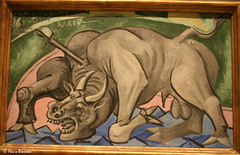
Dying Bull - Pablo Picasso - Série de Nova Iorque: o Museu de Arte Metropolitan - New York's series: The Metropolitan Museum of Art - IMG_20080727_8856
Originally uploaded by Flávio Cruvinel Brandão
Francois Gilot
Antibes
plywood
Cannes
Valauris
"to tickle the mind"
ceramics
Villa Californie
Notre Dame de Vie
Château de Vauvenargues: near the Provençal town of Aix-en-Provence there is a simple mound of earth, covered in grass and ringed by ivy. Perched on top is a curvaceous bronze nude, made by Pablo Picasso in 1933, and exhibited alongside Guernica in the Paris international exhibition of 1937. But, in terms of significance, it doesn’t come close to what lies beneath: the body of the artist himself.
This summer, 36 years after Picasso’s death, the château in the south of France opens its gates to the public for the first time. The Spanish artist bought Château de Vauvenargues in 1958 after he discovered it in the foothills of Mont Sainte-Victoire, the mountain immortalised in countless paintings by Paul Cézanne, the man Picasso regarded as his artistic father.
age 91, 1973
Magnet arts trip to Ft Worth Modern, Kimbell, etc, on Tues, Nov 3
A 56-person bus is being lined up by art history teacher Mrs. Wendy Reed for a tour of Ft Worth museums on Tues, Nov 3.
Stand by for the cost.
Ft Worth Modern
Kimbell Art Museum
Amon Carter Museum / American Art.
Stand by for the cost.
Ft Worth Modern
Kimbell Art Museum
Amon Carter Museum / American Art.
Tuesday, October 13, 2009
The Picasso project
There are 2 parts to the Picasso project -
Visualising Picasso
- 10 images of his work (at least one sculpture and one ceramic work) that are spaced across his long career with brief notation of title, year, museum where the work is found or location of Picasso when he completed the piece. .
Knowing Picasso
- Write 10 multiple-choice questions that span his life and emphasize the primary points of his biography.
Google Docs.
15 pts each.
Picasso Presentation to be shown to the class beginning Tues, Oct 20. Picasso Bio Quiz due in GogleDoc Tues, Oct 20. My plan is to synthesize your questions into an end-of-unit test to be taken Thurs, Oct 22.
Visualising Picasso
- 10 images of his work (at least one sculpture and one ceramic work) that are spaced across his long career with brief notation of title, year, museum where the work is found or location of Picasso when he completed the piece. .
Knowing Picasso
- Write 10 multiple-choice questions that span his life and emphasize the primary points of his biography.
Google Docs.
15 pts each.
Picasso Presentation to be shown to the class beginning Tues, Oct 20. Picasso Bio Quiz due in GogleDoc Tues, Oct 20. My plan is to synthesize your questions into an end-of-unit test to be taken Thurs, Oct 22.
Friday, October 9, 2009
Fine Arts class total assignments at end of 9 weeks
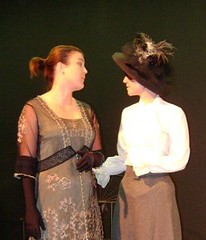
Boston Marriage: Kari Kennon, Kelly Mills, LSUS Black Box Theater, Th, Oct 8; LSUS photo
Originally uploaded by trudeau
1. Comparsion essay / profile of 2 classmates.
2. Graffiti @ Artspace
3. RW Norton Art Foundation
4. Photo essay / RW Norton grounds
5. Art of Africa project
6. Arts Experience for Sept. (restaurant, movie, drama, etc)
7. Southern University Museum of Art Shreveport
These works will each be scored at 15 points.
Additional projects for which you have points -
- Notes on graffiti artists - 11 pts.
- Sculpture / soap relief carving - 5 pts.
Thursday, October 8, 2009
Fine Arts vocab: misogynist, machismo, pacifism
Fine arts vocab:
* misogynist - Misogyny (pronounced /mɪˈsɒdʒɪni/) is hatred (or contempt) of women or girls. Misogyny comes from Greek misogunia (μισογυνία) from misos (μῖσος, "hatred") and gynē (γυνή, "woman"). It is parallel to misandry—the hatred of men or boys. Misogyny is also comparable with (but not the same as) misanthropy which is the hatred of humanity in general. The prefix miso-, meaning 'Hatred' or 'To hate' applies in many other words, such as misandry, misocapny, misogomy, misarchy and misoxeny.
Greek philosophers considered misogyny to be caused by gynophobia, a fear of women.[1] In the late 20th century, feminist theorists proposed misogyny as both a cause and result of patriarchal social structures.[2]
* machismo - Machismo is prominently exhibited or excessive masculinity.[1] As an attitude, machismo ranges from a personal sense of virility to a more extreme male chauvinism. In many cultures, machismo is acceptable and even expected.
* pax - pacifist - Pacifism is the opposition to war or violence as a means of settling disputes or gaining advantage. Pacifism covers a spectrum of views ranging from the belief that international disputes can and should be peacefully resolved; to calls for the abolition of the institutions of the military and war; to opposition to any organization of society through governmental force (anarchist or libertarian pacifism); to rejection of the use of physical violence to obtain political, economic or social goals; to the obliteration of force except in cases where it is absolutely necessary to advance the cause of peace; to opposition to violence under any circumstance, including defense of self and others.
Beginning in the 16th century, the Protestant Reformation gave rise to a variety of new Christian sects, including the historic peace churches. Foremost among them were the Religious Society of Friends (Quakers), Amish, Mennonites and Church of the Brethren. After its founding by Quaker pacifist William Penn, Quaker-controlled colonial Pennsylvania employed an anti-militarist public policy. Unlike residents of many of the colonies, Quakers chose to trade peacefully with the Indians, including for land. The colonial province was, for the 75 years from 1681 to 1756, essentially unarmed and experienced little or no warfare in that period.
* misogynist - Misogyny (pronounced /mɪˈsɒdʒɪni/) is hatred (or contempt) of women or girls. Misogyny comes from Greek misogunia (μισογυνία) from misos (μῖσος, "hatred") and gynē (γυνή, "woman"). It is parallel to misandry—the hatred of men or boys. Misogyny is also comparable with (but not the same as) misanthropy which is the hatred of humanity in general. The prefix miso-, meaning 'Hatred' or 'To hate' applies in many other words, such as misandry, misocapny, misogomy, misarchy and misoxeny.
Greek philosophers considered misogyny to be caused by gynophobia, a fear of women.[1] In the late 20th century, feminist theorists proposed misogyny as both a cause and result of patriarchal social structures.[2]
* machismo - Machismo is prominently exhibited or excessive masculinity.[1] As an attitude, machismo ranges from a personal sense of virility to a more extreme male chauvinism. In many cultures, machismo is acceptable and even expected.
* pax - pacifist - Pacifism is the opposition to war or violence as a means of settling disputes or gaining advantage. Pacifism covers a spectrum of views ranging from the belief that international disputes can and should be peacefully resolved; to calls for the abolition of the institutions of the military and war; to opposition to any organization of society through governmental force (anarchist or libertarian pacifism); to rejection of the use of physical violence to obtain political, economic or social goals; to the obliteration of force except in cases where it is absolutely necessary to advance the cause of peace; to opposition to violence under any circumstance, including defense of self and others.
Beginning in the 16th century, the Protestant Reformation gave rise to a variety of new Christian sects, including the historic peace churches. Foremost among them were the Religious Society of Friends (Quakers), Amish, Mennonites and Church of the Brethren. After its founding by Quaker pacifist William Penn, Quaker-controlled colonial Pennsylvania employed an anti-militarist public policy. Unlike residents of many of the colonies, Quakers chose to trade peacefully with the Indians, including for land. The colonial province was, for the 75 years from 1681 to 1756, essentially unarmed and experienced little or no warfare in that period.
Subscribe to:
Posts (Atom)


